Choosing the right waterer for your chickens is essential for their health and happiness. Understanding when to use cups or nipples can help you get the most out of your setup and ensure your flock always has access to clean, fresh water. By selecting the right attachment for your chickens’ needs and adjusting as they grow or as the seasons change, you can support their wellbeing and make daily care more efficient.
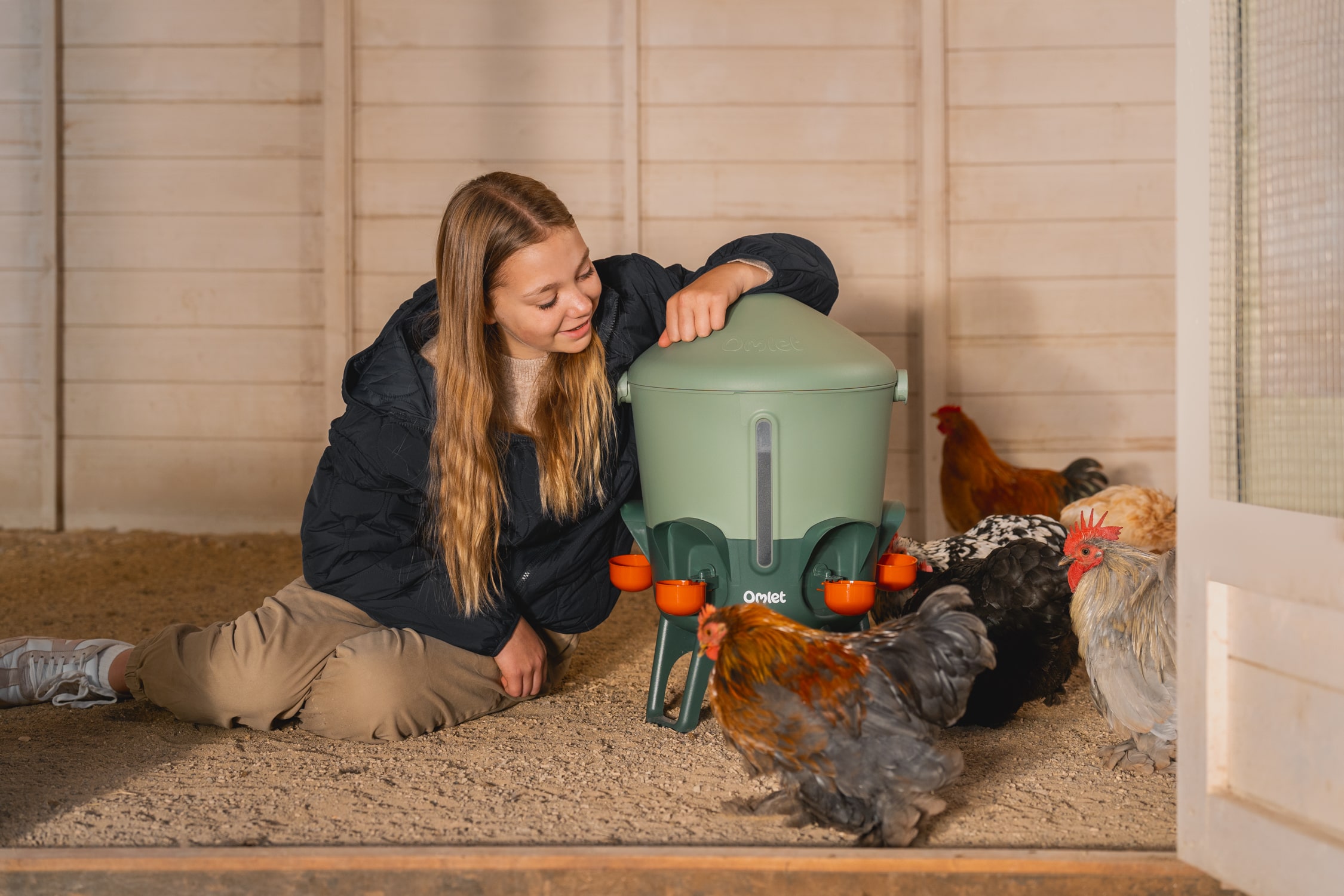
How to choose the right waterer for your flock
Choosing the right waterer for your flock means considering the specific needs of your chickens at every stage and in every season. Young chicks often do best with cup waterers, as the open design makes it easy for them to drink and for you to keep an eye on their water intake. As your flock matures, nipple waterers become a practical option for keeping water cleaner and reducing waste, especially in larger groups or in environments where hygiene is a top priority.
The ideal waterer is one that doesn’t force you to pick just one method. The Omlet Insulated Stay Clean Waterer gives you both options in a single, easy-to-use system. You can start with cups for your pullets, then switch to nipples as your birds grow or as your needs change. By choosing a waterer that adapts to your flock, you ensure that your chickens always have access to fresh, clean water, making daily care simpler.
When to use cups on the Omlet chicken waterer
Cups are a great choice for certain situations and stages of your flock’s life. They provide an open, familiar drinking experience that many chickens, especially young chicks, find easy to use. The open design allows chickens to drink freely, without any training, however in winter the water in the cups will freeze and will need to be checked and any ice broken everyday.
When to use nipples on the Omlet chicken waterer
Nipple attachments are ideal for keeping water clean and flowing all year. Nipples dispense water only when a chicken pecks at them, meaning the clean water is delivered from inside the closed source straight to your chicken’s beak. This keeps every drop crystal clean and free from dirt and debris. This makes nipples a smart option to reduce water waste and frequency of cleaning. However, nipples take some training for chickens who haven’t used them before and need to be placed at the perfect height to make it easy for your hens to drink.
As well as being best for keeping water clean, using nipples with the Omlet Chicken Waterer is best for use in extreme temperatures as the water remains inside the insulated waterer where it keeps a consistent temperature until the moment the chicken pecks it, preventing water warming up in summer and freezing in winter.
Tips for switching between cups and nipples
One of many benefits of the Omlet Insulated Chicken Waterer is the ability to easily switch between cups and nipples. However, it’s best to use one type at a time rather than mixing both as nipples and cups require the waterer to be positioned at different heights for your chickens to be able to drink from them.
If you’re transitioning from cups to nipples, give your flock a little time to adjust and make sure everyone understands how to use the new attachment. You can encourage them by gently tapping the nipple so they see water being released and placing their favorite treat on the nipple. Ensure chickens still have access to an open, cup source of water so they don’t go without while learning. Always monitor your chickens when you make a change to ensure everyone is drinking and staying hydrated.
If you have a mixed-age flock, consider having multiple waterers so young chickens can access cups while learning to use nipples like their elders.
Why the Omlet insulated stay clean waterer is the smart choice
The Omlet Insulated Stay Clean Waterer is designed to adapt to your flock’s changing needs. Its insulated construction keeps water cool in summer and prevents freezing in winter, so your chickens always have access to fresh flowing water. The stay-clean features reduce the time you spend on cleaning and replacing water, and the flexible design means you can quickly switch between cups and nipples as desired.
With the ability to choose the right attachment for your flock and the peace of mind that comes from a well-designed, insulated waterer, you can focus more on enjoying your chickens and less on daily chores.
Quick reference: when to use each attachment
Plastic Cups:
- Best for chicks or hens who haven’t used nipples before
- Best for immediate drinking, no training required
Nipples:
- Keeps water cleaner
- Keeps water at the right temperature in extreme weather
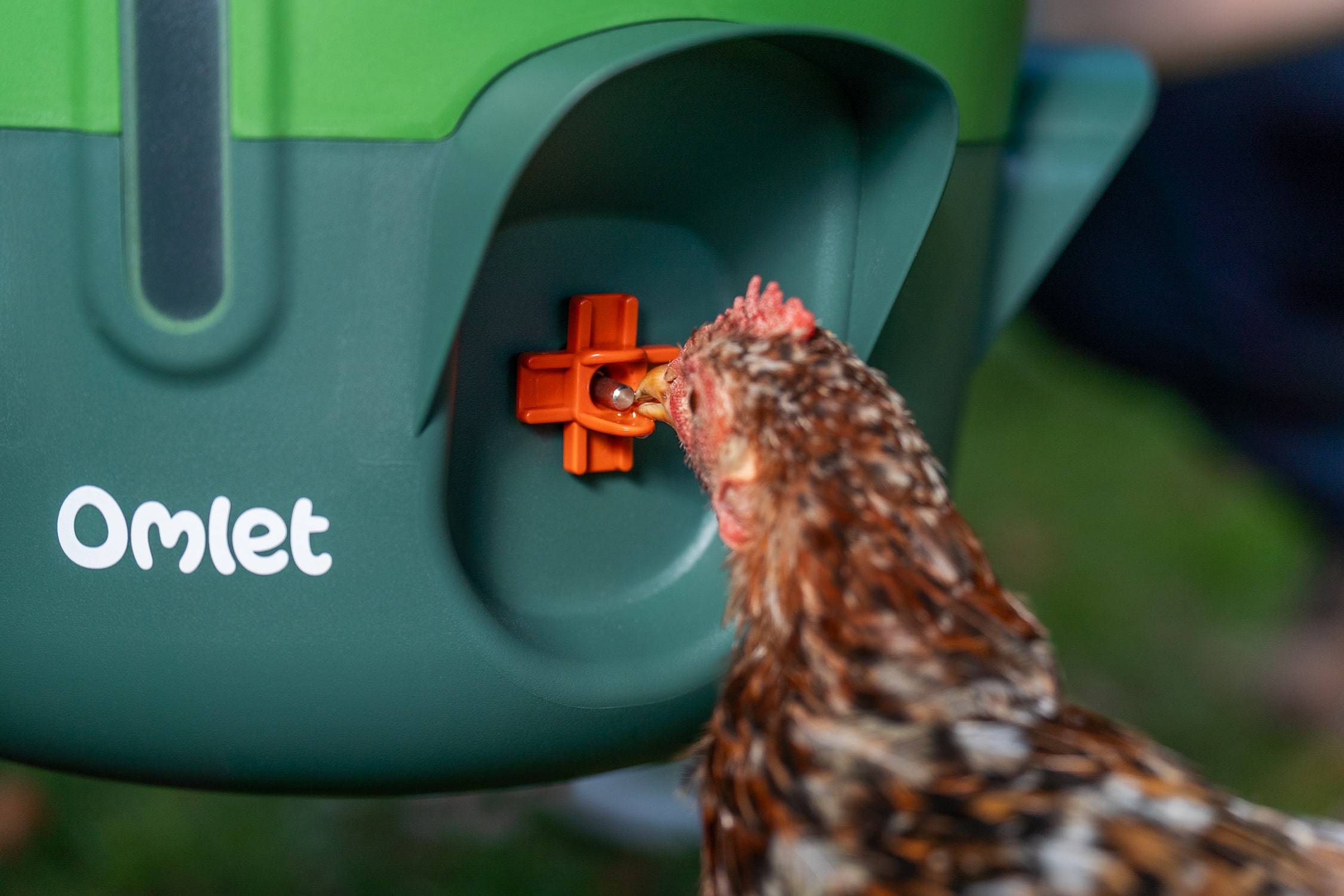
Omlet and your flock
With the Omlet Insulated Stay Clean Waterer, you have the flexibility to provide the best hydration solution for your chickens at every stage. By understanding when to use cups and when to switch to nipples, you can keep your flock healthy, your run cleaner, and your daily routine simpler. The Omlet waterer is designed to make chicken keeping straightforward, reliable, and adaptable – so you can always feel confident you’re giving your flock the care they deserve.
This entry was posted in Chickens
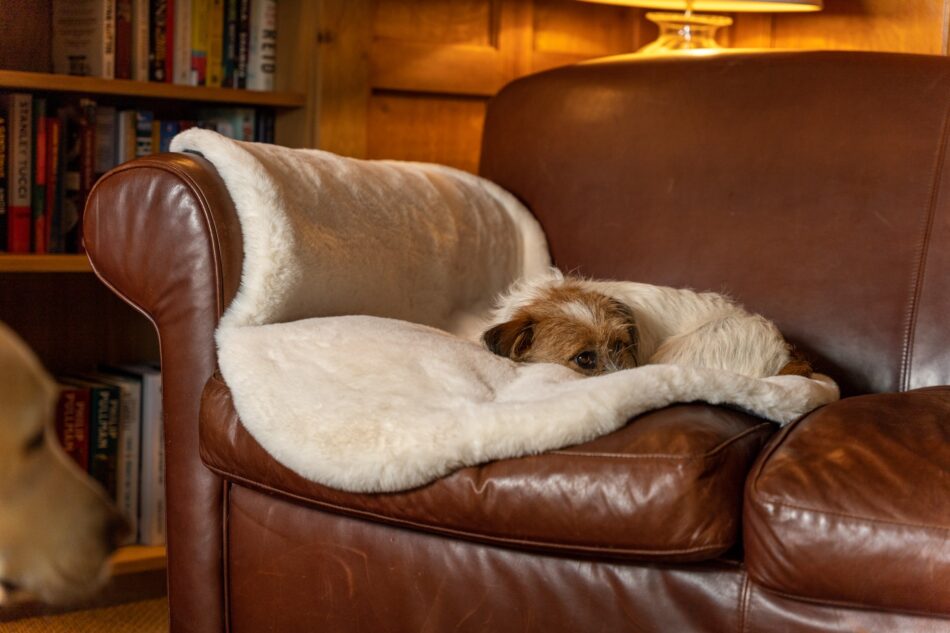
Most dogs dig the winter! Jumping in piles of fluffy snow and running through forests with winter white paws is most dogs’ dream! But depending on dog breed, some find the winter season more magical than others.
While enjoying the beauty of the snowy colder months with your dog can be loads of fun, without proper care and preparation, extreme weather can also be quite treacherous for dogs and humans alike! That’s why we created this list of 5 helpful tips to keep your dog safe this winter.
Shorter walks
Walking in a winter wonderland is a dreamy thought especially if it’s with your bestest furry four-legged friend. But as idyllic as that holiday scene may be, the truth is, some parts of the country get entirely too cold for dogs to handle being outside for extended periods of time.
So what does that mean for your dog’s treasured walks each day? Just because it’s cold out doesn’t mean their walks have to stop! Instead, increase your usual 1-2 long walks per day to 3-5 short walks so the amount of time spent outside is the same, but in shorter periods of time.
This way, your dog can still enjoy the fresh air and release some energy but without getting frozen paws in the process! Don’t forget to thoroughly dry those foot pads before coming back inside – because no dog likes cold, wet feet.
Appropriate attire
While you are digging through your closet to pull out your wooly winter sweaters, feel free to fetch a dog coat (or two!) for your furry friend as well! Even though dogs are covered in coats of hair and fur, they can still get too cold in the winter months if not protected.
Your dog’s ability to handle colder temperatures is entirely dependent upon their age, breed, and size. Thicker coat breeds, such as Huskies and Akitas, may be able to handle lower temperatures, but even these “winter dogs” need to have protective gear when being outside in winter!
Make sure you have a warm, waterproof dog jacket or sweater that is not too tightly fitting for your dog to wear. If your part of the country has snow on the ground most of winter, think about getting some dog booties as well for your pup. The salt and ice can get stuck in their paws on even short intermittent walks causing irritation later if not cleaned out.
And for those last potty breaks before bed, attach a flashlight to your dog’s harness or collar so both you and your dog can avoid any icy patches!
Winter dog grooming
Making sure your dog’s fur is well-groomed is not just a hot weather activity. In fact, keeping up with your dog’s coat in the winter is almost just as important as any other time of the year!
Here’s why – a healthy coat on a dog acts like a temperature regulator. It can keep them cool in the summer and warm in the winter. So maintaining a regular brushing schedule of your dog’s coat is essential during winter to ensure their bodies continue to do what they naturally do which is keep them comfortable! And be sure to avoid any complete hair shavings during this time of year.
What about the paws? Don’t forget to pay closer attention to your dog’s nails this winter and keep them trimmed. Walking on snow lined pathways may seem soft and nice, but this means that your dog’s paws aren’t getting the natural manicure they are used to when walking on hard concrete.
Indoor winter fun
Frost-covered windows and snowy white drifts outside create a need for warm places to cuddle inside! And who better to enjoy a cozy snuggle with than your dog?
When weather conditions become too extreme to be outside longer than a quick puppy pee, that means it’s time to create a cozy cuddleland indoors! In order to avoid cabin fever, have lots of dog toys on hand to keep your pup physically and mentally active. This is a great time to play new games of “hide and fetch” with your dog so they can get out some energy while also engaging more with you!
And after they have a good round of tug and play, be sure your dog has a cozy spot to snuggle into for a nap or the night. Even if your house is heated, the floorboards can still be too cool for a dog to lay on, so get a bed that is elevated to allow for more warm air to flow around them. The Topology Dog Bed designed by Omlet is a great option as the toppers and mattress covers are machine washable, making it super easy to clean!
Is your dog more of a “need a retreat” kind of dog? Then get them a comfortable dog den of their own to get cozy in like the Fido Nook Dog Crate designed by Omlet. Add a super soft sheepskin blanket to their sleeping quarters and you will have your dog dreaming of sugar plum fairies in no time!
Cold weather pet care
Dogs are no different from humans when it comes to health and the dangers of extreme cold weather conditions. Have you ever noticed that small aches and pains in your joints tend to feel worse in the winter? That’s because colder temperatures increase the pressure inside your joints, causing pain receptors to be more sensitive and resulting in a greater sense of discomfort.
Well the same is true for dog’s who have any medical conditions with joint pain or arthritis. The colder winter weather decreases their circulation and increases the stiffness in their already strained muscles and joints.
So what can you do to make your dog more comfortable this winter? Several factors can account for your dog’s medical condition so it’s always best to consult with your veterinarian about your dog’s specific needs. But some best practices include keeping weight gain at a minimum, finding lots of ways to keep them warm, and being sure they have a comfortable dog bed to rest on.
Dogs who are prone to joint pain should also continue to move despite the thought that rest will make it better. Just be sure to stick to walks on cleared paths to avoid the slippery ice and snow that can make walking difficult for both you and your dog!
Winter is here! Experiencing these colder months with your dog can make this season more memorable and enjoyable for everyone as long safety measures are in place! So gather the dog blankets, heat up the hot chocolate and watch the snow as it gently falls out your window. With these 5 tips and lots of your love, your dog will be kept safe and warm all winter long!
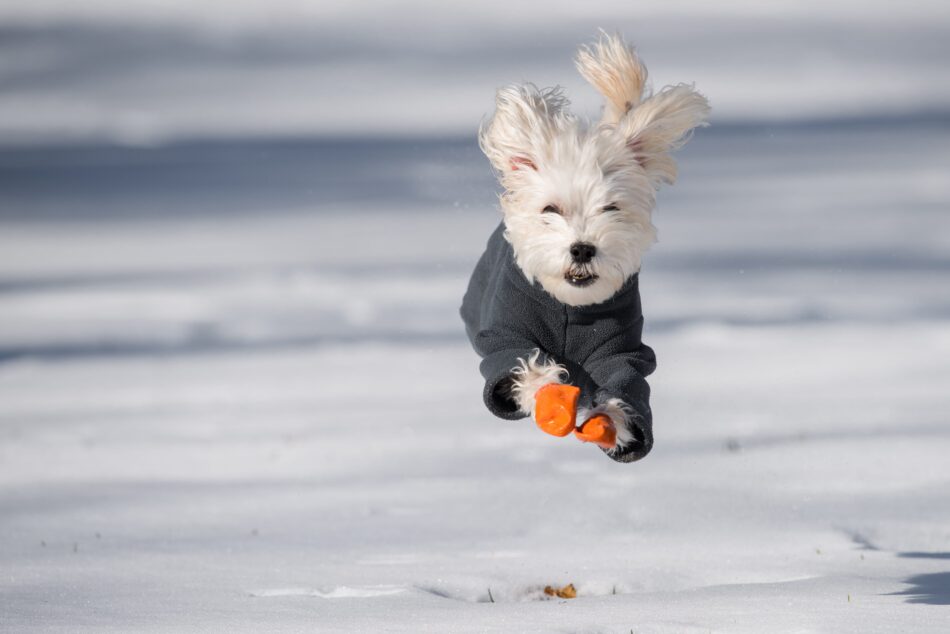
This entry was posted in Dogs
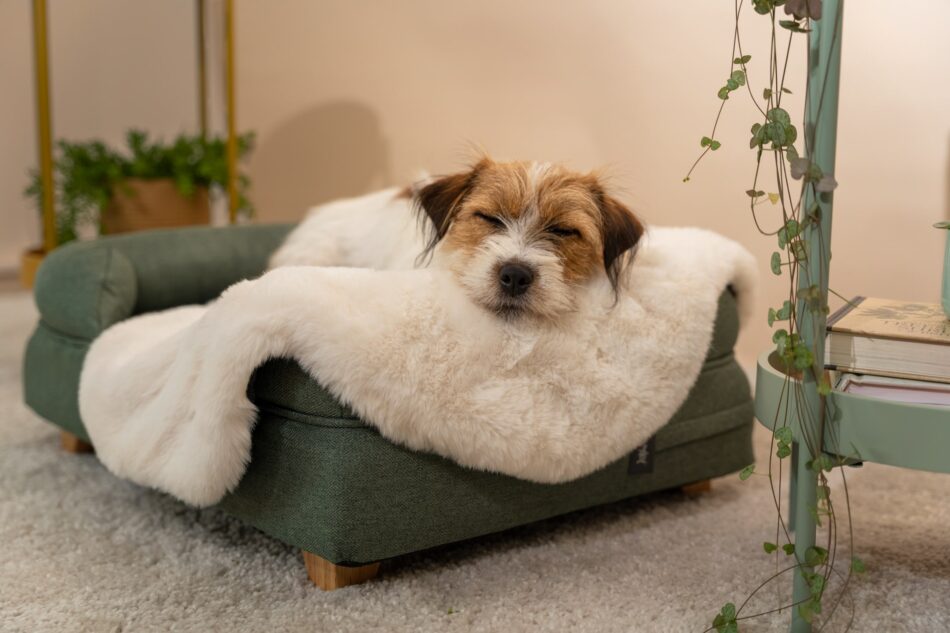
The leaves are falling and temperatures are dropping. Fall has faded into winter and the crisp air hints at colder weather to come. As you move into winter with a cozy jacket, help your pooch conquer the cold and welcome in the new season by your side. Follow these tips for transitioning your dog into winter and watch them wag their tail goodbye to crunchy leaves and hello to snow-filled strolls.
How cold is too cold?
Most dogs can tolerate cold temperatures pretty well – they do have a built-in fur coat, after all. But how do you know when winter cold is too much for Fido? The best way to temperature check your dog is by looking out for these signs:
- Sitting in a hunched position with their tail tucked in.
- Whining incessantly – this is usually dog speak for “I’m cold – let’s go get warm”.
- Reluctant to go on a walk when they usually love being outside.
These breeds were made for winter
All dogs need some extra care and warmth during the winter months but certain breeds are more susceptible to becoming too cold. Those most likely to need the help of a winter coat are the smaller, short-haired breeds like beagles, pugs, and chihuahuas. Hardier dog breeds such as Siberian huskies and malamutes, on the other hand, fare much better in cooler climates.
Don’t be fooled by their size – there are a few larger dog breeds that struggle in the winter, too. Great Danes, Salukis and German shorthaired pointers are a few examples that are more averse to chilly temperatures due to their shorter coats or minimal body fat.
You’ll want to pay close attention to your dog’s body language on cooler days. Temperatures of 45℉ or below can become risky for long walks or extended outdoor play for dogs susceptible to getting too cold, including older dogs as well.
Winter entertainment essentials
Cold-weather walks around the block may suffice in some parts of the country for dogs this winter, but when the temperatures start to plummet too low, it’s time to move the exercise indoors.
Keeping your dog stimulated indoors is important all year round but especially when conditions mean daily walkies might be off-limits. Here are a few ways to keep your dog active indoors when it’s too cold to play outside:
- Toys, toys, and toys. Whether plush or hard, squeaky or silent, dog toys are an excellent way to keep your dog’s playtime going when indoors. Plus, a game of tug of war or indoor fetch are great bonding activities for you and your pet.
- Hide and see the treats. One of the best ways to get your dog moving is to have them hunt for hidden treats throughout the house. This game doubles as brain training too, so your pup will be able to get both a physical and mental workout in.
- Have a playdate. When it’s too cold to meet up at your favorite dog park, consider having a dog friend over instead to burn off some energy.
- Training and tricks. Take advantage of the extra time with your furry friend by teaching them a new trick. Keep sessions short and be sure to use plenty of treats and praise to get Fido motivated.
Creating your dog’s winter wonderland
To make sure your dog stays snug this season, create a winter wonderland inside by cozying up your quarters. Winterproofing your home for your dog has never been so easy with Omlet’s range of ingeniously designed products to take you through the year.
Nothing’s better than coming home to a warm bed after being outside on a winter’s day. And with Omlet’s Topology Dog Bed not only will you provide your pup with an unparalleled sleep experience on a supportive memory foam mattress, but you can customize their topper from a variety of options that keep them warm and cozy all winter long. Simply zip on a new topper when it’s time to get comfy and zip it off to clean those muddy paw prints with a quick spin in the machine.
Choose from the Sheepskin topper for the ultimate snuggly soft sleep, or for post-snowy walkies, the Microfiber topper is quick drying to get them feeling warm again in no time.
To take their bed to another level of comfort, layer up with the Omlet Luxury Faux Sheepskin Dog Blanket. Or place the plush throw on your bed or couch so you can share a snuggle together. Plus, with three sizes to choose from, you can choose a blanket big enough to wrap around any dog.
Should your dog’s diet change in winter?
While humans may sometimes gain an extra layer of warmth during the holiday seasons, be careful your dog doesn’t follow suit. Just like us, dogs may try and consume more calories during winter to try and create an extra layer of warmth. But, overconsumption of food can lead to health complications in the long run if not watched carefully.
If your dog is active the rest of the year but they start to slow down during winter, you’ll want to maintain a steady calorie intake to not add too much weight. Speak to your veterinarian about switching their diet away from foods high in carbohydrates and more protein and fiber-rich foods to keep them fuller longer.
An extra helping of omega-3 will also be beneficial for your pup this season. This will help with keeping their skin and coat in top condition, free from flaking and itching. Your veterinarian will be able to tell you what they think is best for your pet, but dog-friendly omega-3 supplements are readily available online or in your local pet store.
Omlet and your dog’s winter
Winter can be one of the best seasons, especially with your dog by your side. While you might be spending more time on the couch and less time out on adventures, with products like the Topology Dog Bed, Luxury Faux Sheepskin Dog Blanket and dog toys from Omlet, transitioning into this wonderful time of year has never been easier.
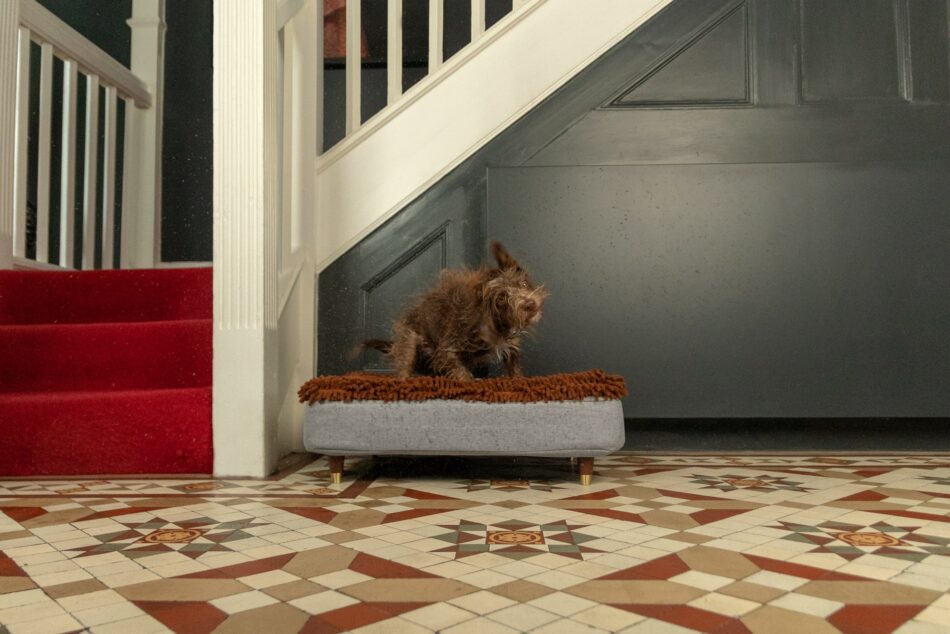
This entry was posted in Dogs
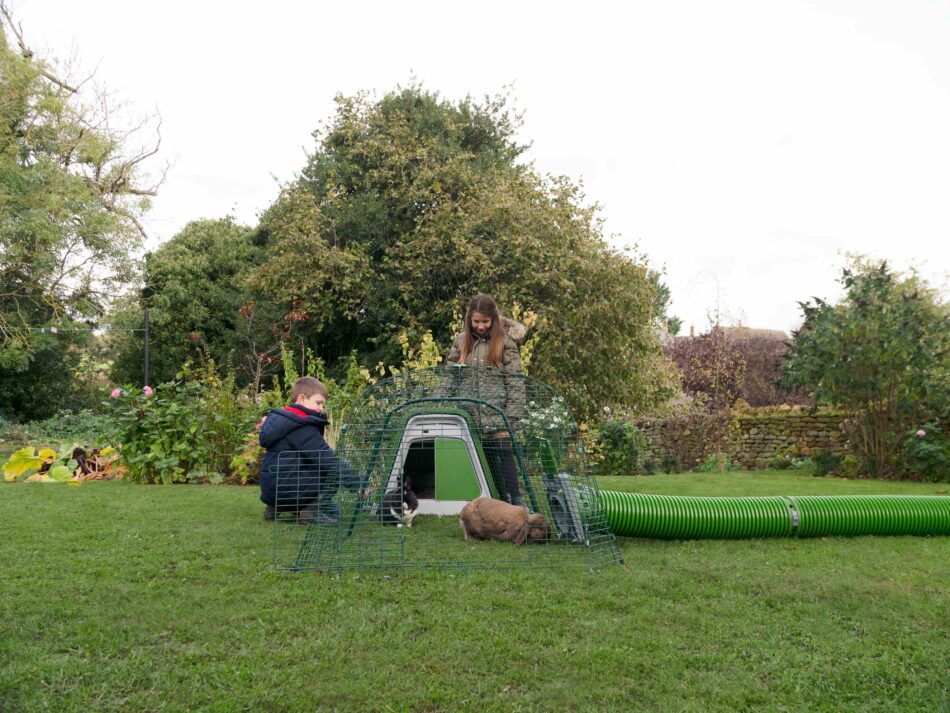
Winter is highly anticipated by some, and a source of apprehension for others. Depending on where you live, your outdoor rabbit could fall into either category! Rabbits that live in states that experience long, hot summers look forward to winter with glee. However, bunnies living in states that experience bitter cold in the winter may not share the same excitement with their neighbors to the south. The good news is that rabbits are naturally able to handle the cold better than excessive heat, and with a helping hand from their human, they’ll be ready to withstand the cold winter months.
Your pet rabbit’s wild counterparts have multiple ways of managing their wellbeing in the cold. For instance, rabbits have a burrowing instinct, as the underground is more insulated and temperature-regulated than the outside air and at the mercy of the weather. But since burrowing down in the ground all winter isn’t an option for most domesticated rabbits, we’ve created rabbit hutches and accessories at Omlet to simulate the ideal conditions for your rabbit to withstand wild weather of all varieties!
With a few minor adjustments to your rabbit’s diet and routine, along with products designed by Omlet to keep the weather out and the warmth in, your rabbit can spend the winter months in their element – safe from the elements!
Cold-natured
Rabbits have dense coats that insulate them from both heat and cold. In the summertime, you’ll notice your rabbit “blowing” their coat frequently in an effort to release their dense undercoat in favor of the longer “guard hairs” on top. As the days shorten and grow colder, outdoor rabbits will shed less and grow out their insulating undercoat once again in preparation for winter. You’ll notice your bunny looking particularly poofy by the time cold weather sets in!
Once they’ve donned their winter coats (courtesy of nature!), bunnies are right at home in the cold! Like their wild counterparts, most pet rabbits will appear more energetic and playful in the colder months. But their increased activity isn’t just out of joy for the season – it’s also to create more energy and heat to warm themselves up. Nevertheless, it’s fun to watch pet rabbits increase their body temperatures through zoomies, hopping, binkies, and social play!
Multiple factors such as breed, size, housing conditions, and age need to be taken into consideration when determining how cold is too cold for your rabbit. As a general rule, most rabbits should be comfortable in temperatures above freezing. Once the weather hits 32℉, it’s time to evaluate how your bunny is faring.
For more frequently asked questions regarding keeping your pet rabbit outside during the winter, visit: Will My Rabbits Be Ok Outside in the Winter?
Blizzards and bunnies
Rabbits don’t mind a little snow, but if you’re in an area that experiences hard frosts and blizzard conditions, you’ll need to bolster your bunny’s shelter!
One of the best ways to keep your outdoor rabbit warm is to mimic their natural tactics in the wild. Bunnies burrow, nest, and huddle together for warmth – all of which you can recreate for your pet rabbit. Insulation, both in the wild and in your backyard, is a rabbit’s best friend in the cold.
Think of your rabbit’s hutch as their burrow. At Omlet, we’ve invented all of our rabbit products to maintain ideal temperatures and conditions for rabbits – just like they seek out in the wild. By selecting a well designed home for your bunny, such as the Eglu Go Rabbit Hutch, they will have an insulated hideaway from the cold that provides ample ventilation without sacrificing warmth. But unlike a bunny-engineered burrow, the Eglu Go Rabbit Hutch is waterproof and predator-resistant for when critters come lurking.
For frigid cold snaps, an Extreme Temperature Blanket is an excellent added layer of insulation for your rabbit’s hutch. Like any good insulation, the material won’t become waterlogged when the snow begins to melt, and traps extra heat underneath to further warm the hutch.
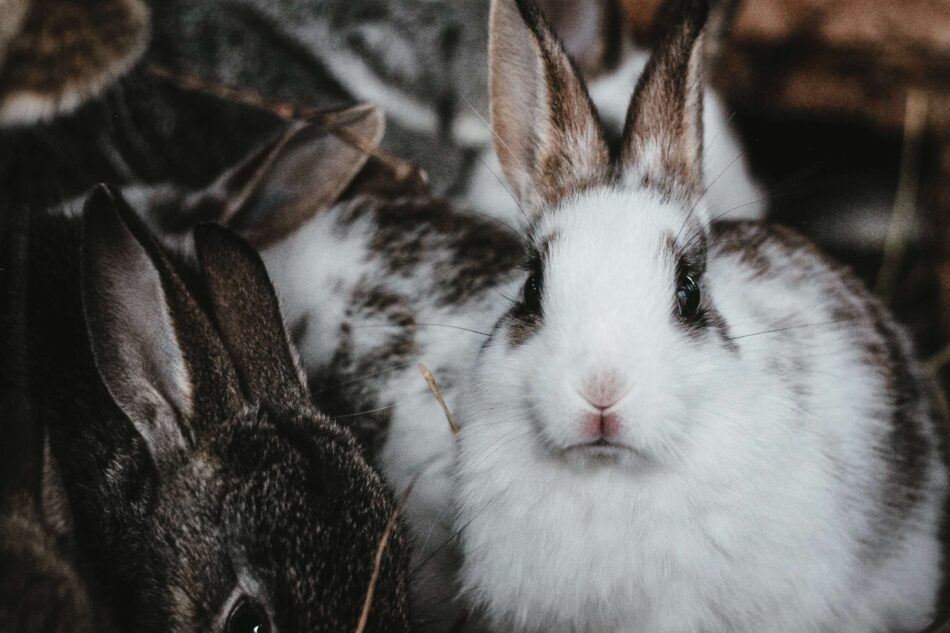
Wild winter weather
The winter season is unpredictable at best, and downright wild at its worst! Cold fronts can come out of nowhere, bringing temperature drops and heavy sleet or snow.
Rabbits, being the intuitive and sensitive animals that they are, can sense when a storm is coming. They can sense atmospheric pressure changes, which will drive them to seek shelter and hunker down. When seeking shelter, rabbits will choose the closest cover available. By placing a few Zippi Rabbit Shelters in their run, you can make sure your rabbit has ample opportunity to escape from the elements.
But you can also create a silver-lining to those winter storm clouds by creating a winter wonderland play-scape for your bunnies! By using a combination of Zippi Rabbit Tunnels, Zippi Rabbit Platforms, and Zippi Rabbit Shelters, you can design a winter-friendly playground that will make your bunny binky with joy!
Health and dietary considerations for winter
Rabbits need different care in the cold months vs the warmer months. You’ll want to inspect your rabbit’s coat before the first cold snap of the season. Check to make sure their undercoat is thick and healthy, and that they don’t have any patches where their hair has not grown in fully (rabbits may have bare or thinned patches of fur from rubbing, playing with each other, or from nervous grooming habits).
Make sure all water bottles or crocks are either insulated or heated to prevent freezing. Heating water on the stove or in the microwave several times a day to add to your rabbit’s watering device is another way of keeping their water thawed and palatable.
Rabbits also ramp up their metabolisms in the winter, and they’ll need more calories to support and maintain their increase in body temperature. They may pass on a hot cup of tea or cocoa, but your rabbit will thank you for extra hay and hay-based pellets during cold weather! You can give treats as usual, but additional treats aren’t necessary. Thanks to their unique digestive system, rabbits benefit the most from foods high in fiber – the longer it takes to digest, the more heat gets generated. Timothy hay, orchard grass, oat hay, and meadow hay are all energy-lending options that should be available at all times to your rabbit. Pelleted feed made primarily from hay should be free-fed as well. If you’re feeding your rabbit a blend (feed that has colored pellets, cracked corn, or seeds) once or twice a day, you’ll want to transition to feeding a pellet feed before the winter. You can save their blended feed for a special treat to be given in small amounts a few times a week!
It’s important to remember that rabbits do not hibernate. In fact, they become even more active during the colder months! If you notice your rabbit acting lethargic or sluggish, bring them inside and contact your veterinarian. An underactive bunny in the winter is either too cold, or will become too cold very quickly!
It’s all in the design
Preparation is the best method for caring for your rabbit in the cold months. But wouldn’t it be nice to have rabbit-housing solutions that work not only in the cold, but also in the heat?
We don’t want you to have to swap out setups every time the seasons change! That’s why we’ve invented one-product-suits-all solutions for caring for and enjoying your pets.
The Eglu Go Rabbit Hutch was designed to keep your rabbit’s thermostat at an even level all year long. And, with an added Extreme Temperature Blanket, you’ll give your bunny the highest level of comfort possible to not only endure the winter months, but to enjoy them!
And don’t forget that while creating a happy winter-home is important for your rabbit, playtime doesn’t have to fall to the wayside just because it’s chilly! An Outdoor Rabbit Run gives you plenty of space to create a fun playground for your rabbit that you can walk in and enjoy with them!
No matter where you spend your winter, Omlet is here to help you and your rabbit enjoy this season together. Whatever the weather – from temperate to frigid- we’ve thought up the products to cover your rabbit from every angle!
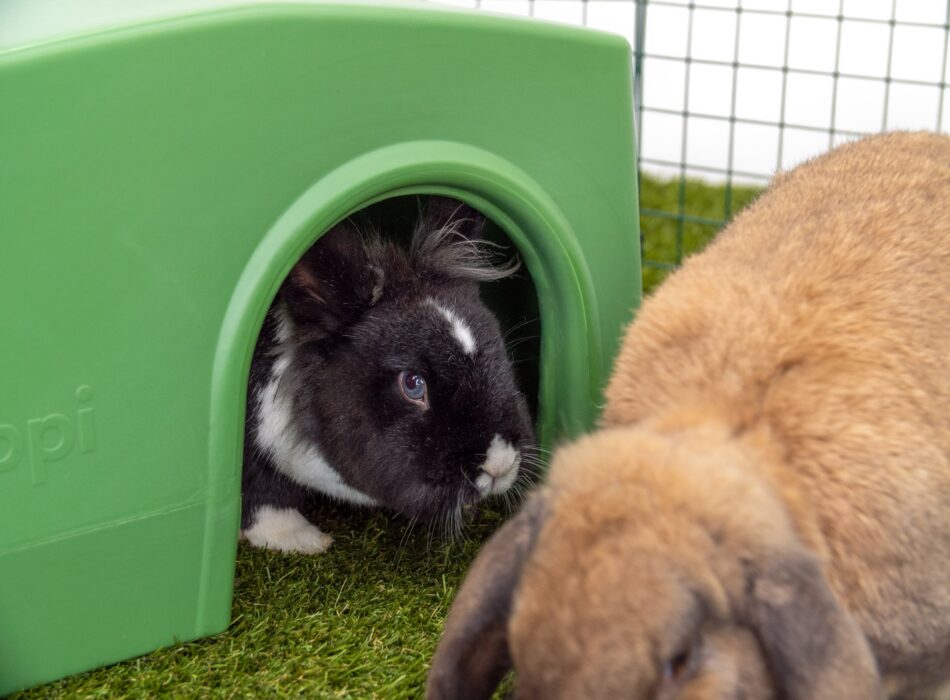
This entry was posted in Rabbits
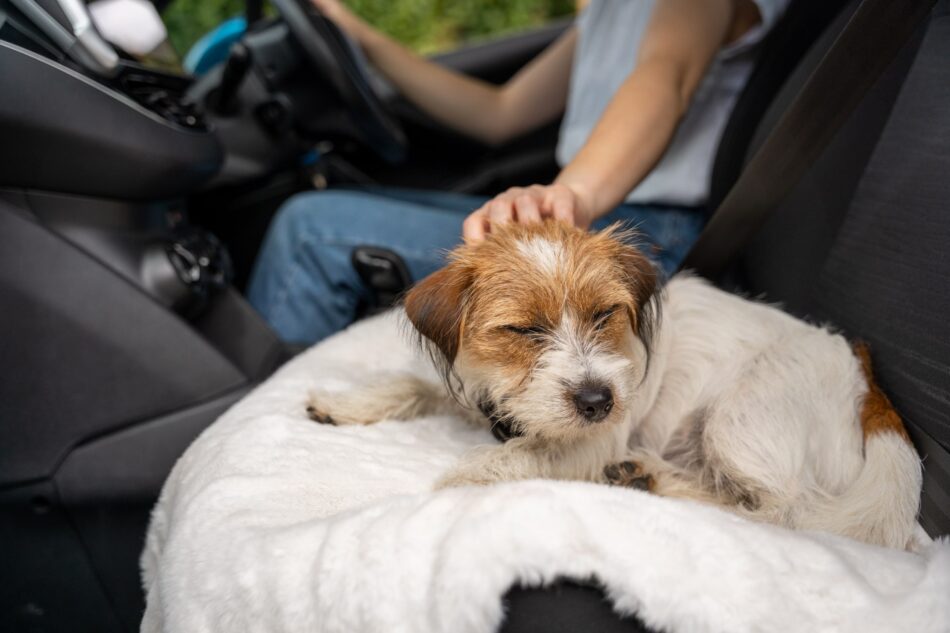
Winter is here, and the chilly weather means that our pets could all benefit from a bit of our help to try and keep snug. As a dog owner, you may be wondering what exactly you can do to keep your dog warm this season. How about investing in an extra cosy dog bed? Or maybe you’ve considered buying them a jacket for them to wear on walks? But have you ever thought about getting your dog their own blanket?
Will all dogs benefit from a blanket?
Some dogs struggle to regulate their body temperature more than others, which means they need extra warmth from a blanket, especially in the colder weather. Older dogs, in particular, have a weaker immune system and are more likely to develop joint pain such as arthritis as they get older. As a result, they have a harder time trying to stay warm, which is why they’d often rather stay out of the cold weather and relax inside under a dog blanket to keep toasty.
Smaller dogs, especially toy breeds such as Toy Poodles and Yorkshire Terriers, can also have a hard time over winter. This is because bigger dogs have a smaller skin surface area to body weight ratio in comparison to smaller breeds. Put simply, this means that small dogs lose heat at a quicker rate. Furthermore, finely boned dogs that weigh less like Greyhounds and Whippets also feel the cold more, as they have less fat to keep them insulated.
When it comes to the cold, the general rule of thumb is that if it’s too cold for you, then it’s too cold for your dog to go outside. Most dogs are happy to be outside for long periods of time until the temperature drops below 7°C but with vulnerable dogs, it’s important to be even more cautious with taking them outside during the winter. You can read more about this on our previous blog Is My Dog Too Cold?.
All dogs, however, can benefit from having a warm blanket, even if they don’t fall into the vulnerable category of being susceptible to finding the cold weather particularly difficult. The Omlet Luxury Faux Sheepskin Dog Blanket is a great option to go for if you’re looking for a suitable blanket to meet your pup’s needs, regardless of size or age. The throw is available in three different sizes for you to choose from, making it the ideal pet blanket for any dog.
If a dog’s fur keeps them warm, then why do they need a blanket?
Whilst it’s true that one of the main purposes of dogs’ fur is to keep them protected from the outside elements such as the weather, this doesn’t entirely stop them from feeling the cold altogether. A good way to think about this is how we also need the help of a few added layers of warmer clothing in colder weather. It’s also important as dog owners to remember that some dogs’ fur makes them more equipped to handle the cold than others, just as age or body weight can have an impact. For example, dog breeds such as Huskies and Saint Bernards have particularly thick coats, which provide them with an extra layer of warmth, making them the best dogs for tolerating cold temperatures and snow. Some breeds have shorter, thinner coats, so will benefit more from the warmth of a dog blanket.
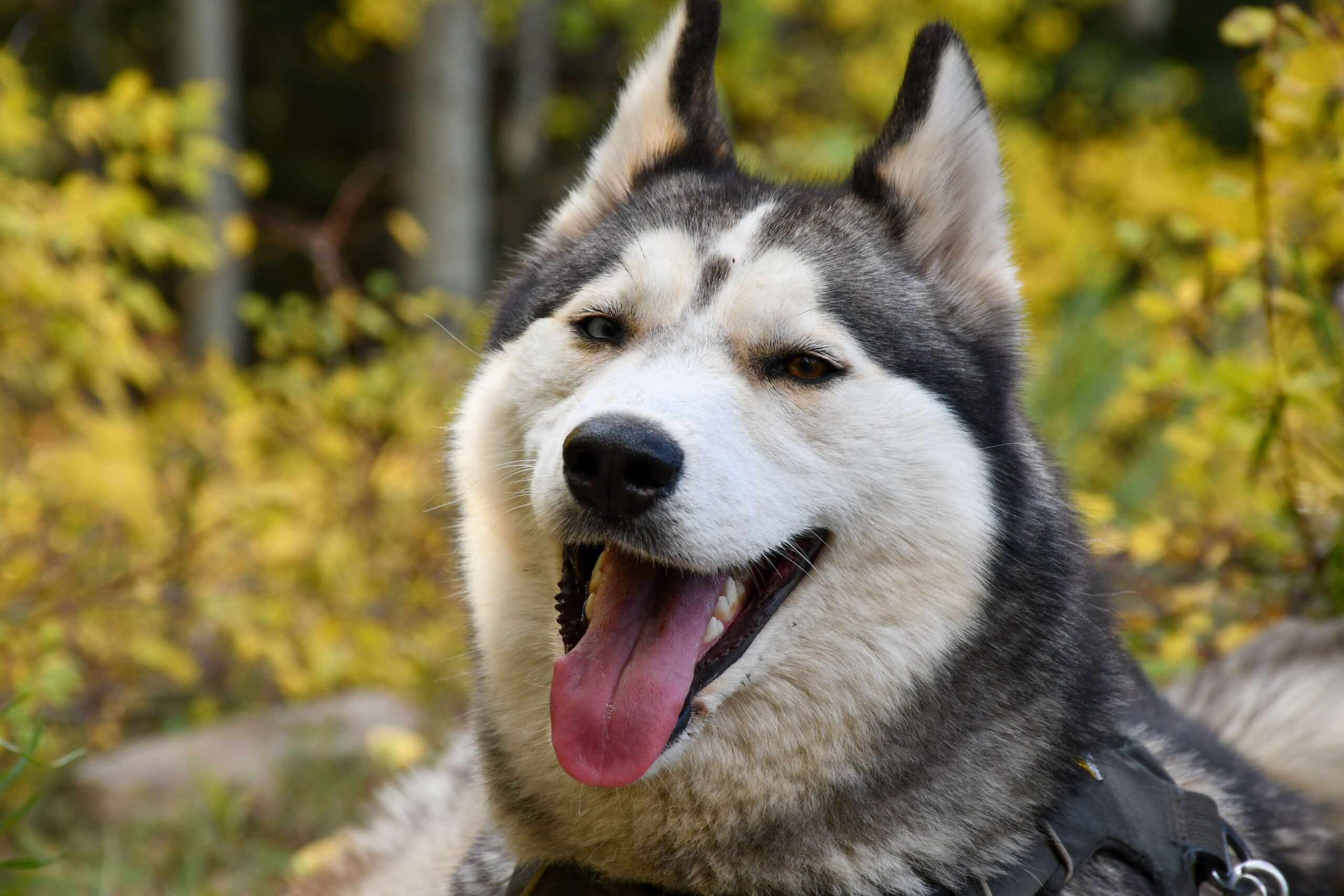
Are dog blankets only for winter?
Just like us, dogs still need a comfortable place to rest all year round and a blanket offers more than just warmth over winter for our furry friends. Did you know that it’s a natural instinct for dogs to ‘nest’, or create their own den, which they can seek shelter under, the same way in which they use a blanket? However, we’ll look more closely into the other benefits of dog blankets below.
What are the benefits of dog blankets?
A great night’s sleep for your dog
Dogs love to snooze, and having a comfortable spot to rest their heads is key to a great night’s sleep. Providing your pup with a cosy blanket for their bed or on top of where your dog sleeps will guarantee the deep, dreamy sleep they deserve, particularly on cold nights!
Can help relieve your dog’s anxiety
Dog blankets can be taken anywhere, meaning that they can be a useful tool for reducing your dog’s anxiety. Giving your dog an item that they associate with their home from the smell and feel of the blanket will provide them with a sense of security in new environments when they feel nervous.
Protects your furniture
As well as dog blankets benefitting your dogs, they can benefit owners, too! Pet blankets can be placed on furniture around the home where your dog usually relaxes, meaning that your couch or bed can be protected from muddy paws and fur.
Keeps your home looking stylish
Dog blankets can also add a stylish look to your home! The stylish design of the Omlet Luxury Faux Sheepskin Dog Blanket is perfect for complementing any home decor!
Comfort is key for our beloved dogs, and we only want the best for our pets. So now we know why dog blankets are so important to our furry friends, who wouldn’t want one?
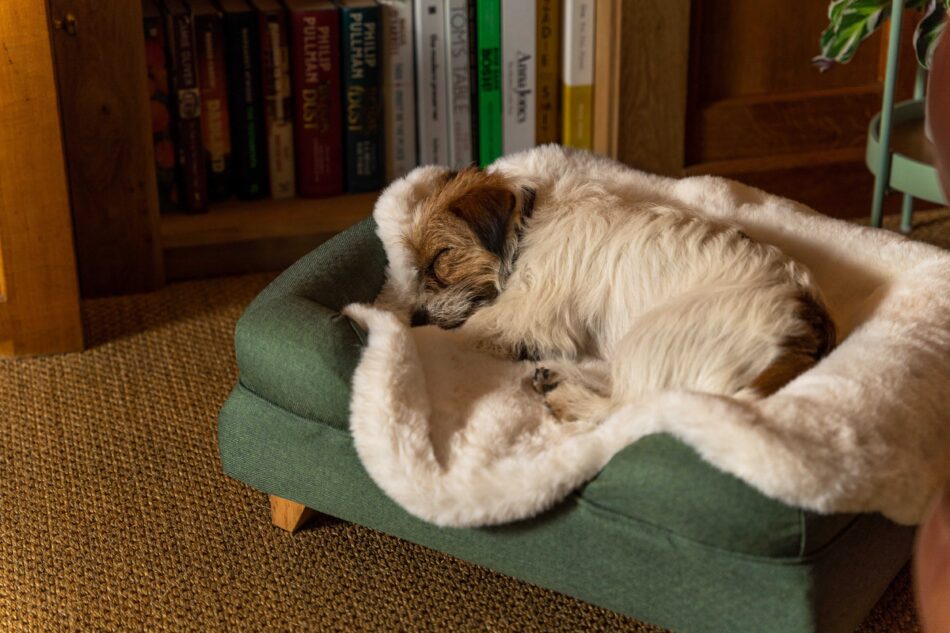
This entry was posted in Dogs
Winter might bring frosty mornings and snowy days, but with a little know-how and proper insulation, you can keep your flock cozy and content all season long. We know you care deeply about your chickens, and we’re here to help you every step of the way. In this handy FAQ guide, you’ll find answers to your top winter chicken care questions so you can feel confident, prepared, and ready to enjoy the magic of winter with your feathered friends.
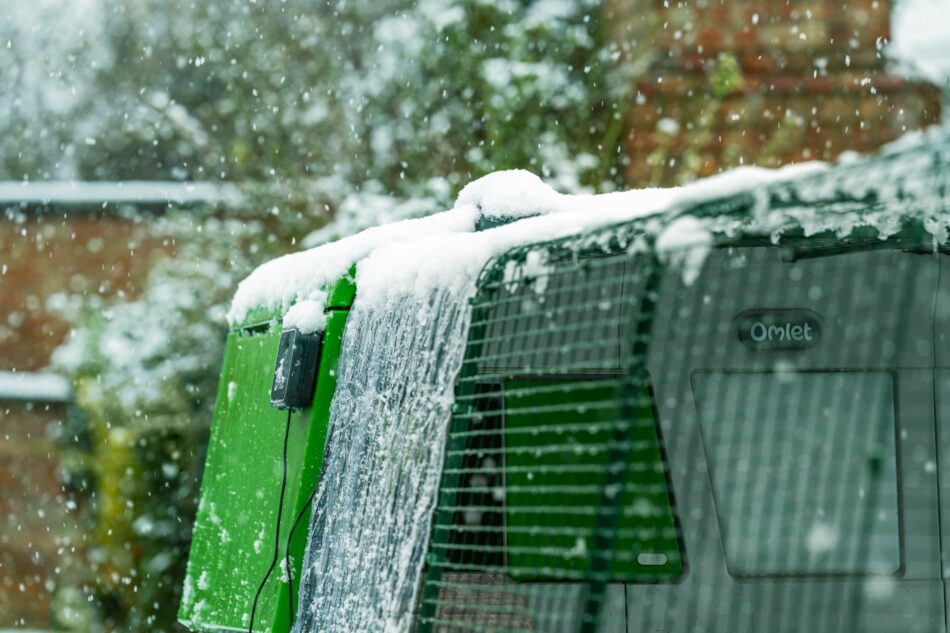
Will my chickens get too cold over winter?
You might be surprised to learn that your chickens are natural cold-weather experts. They acclimate wonderfully to chilly temperatures and often thrive in cooler conditions compared to sweltering heat. With an insulated coop, like the Eglu Cube Chicken Coop, keeping them snug is a breeze. During the cold months, you may notice your flock fluffing up their feathers or cozying together for extra warmth. Much like other birds, they sometimes stand on one leg to conserve body heat and protect their feet from the icy ground.
Can chickens get frostbite?
While your chickens are unlikely to overheat or get too chilly inside a well-prepared coop, be mindful of frostbite and hypothermia. These issues typically arise due to excessive moisture in your chicken coop rather than just the cold itself. Opt for a coop with draft-free ventilation to keep moisture at bay. Keep an eye on breeds with big combs and wattles, as these areas are more vulnerable to frostbite. A gentle daily application of Vaseline can help protect these sensitive spots.
Do I need to insulate my chicken coop?
A well-insulated chicken coop, such as the Eglu, captures your chickens’ body heat inside, keeping them warm while barring cold air from sneaking in. These coops are designed thoughtfully to allow airflow and prevent moisture buildup without causing drafty chills. For extra protection during extreme weather, you can enhance their safety with Omlet’s range of insulating blankets and jackets. And if you don’t have an Eglu, a wooden coop can be insulated with bubble-wrap, cardboard, or even old rugs, carpet remnants, and blankets. Remember to add some extra bedding too.
Should I heat my chicken coop?
Heating your hen house might actually discourage your chickens from venturing outdoors. When a coop is too warm, your feathered friends may miss out on the fresh air and exercise they need to stay healthy and happy. Moreover, a sudden temperature drop, especially during a power outage in a winter storm, could shock your chickens. It’s important to note that heat fixtures, brooder lamps, or panels pose a fire risk. Steer clear of electric heaters, gas-powered heaters, or open flames for the safety of your flock.
What should I feed my chickens in winter?
During winter, continuing to provide your chickens with a balanced diet of high-quality layer pellets is key to keeping them healthy and energized. They tend to eat a bit more in the cold to keep their metabolism running, so a slight boost in feed is a great idea. Supplementing their diet with additional vitamins and minerals can bolster their immune systems through the chilly season.
What temperature should chicken water be?
Your chickens’ water doesn’t need to be warm, but it should always be fresh and unfrozen. Ideally, keep their water between 50°F and 59°F (10-15°C), so it’s easy for your flock to drink, even on the chilliest days. Ensure it doesn’t drop below 41°F (5°C) as this can prevent your chickens from getting enough water which can impact egg production and health. With a little help from an enclosed chicken waterer, you can make sure your hens stay hydrated and happy all winter long.
How do you keep chicken water from freezing?
Keep a watchful eye on their water supply, it can easily freeze over in the colder months. Many chicken keepers will visit their hens multiple times a day to break the ice in their waterer, or try adding moving objects like ping pong balls to keep water fluid, but if you continue to have problems with water freezing, consider investing in an insulated chicken waterer. Designed to shield water from the elements, Omlet’s innovative waterer has thick insulation that keeps the water inside at a comfortable drinking temperature and prevents freezing, so your chickens always have clean water to drink.
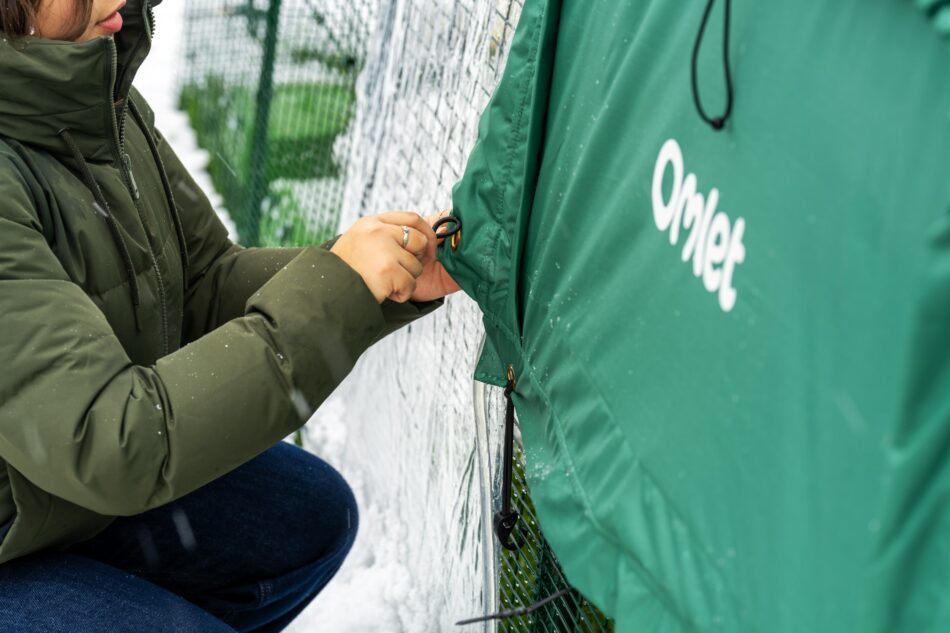
Will my chickens become under the weather over winter?
Just as you might feel a little off during the cold months, some of your chickens could feel under the weather too. Keep an eye out for signs like coughing, sneezing, or lethargy. By staying alert to these symptoms, you can promptly address any health issues. For more tips on tending to your flock’s well-being, check out the Omlet guide on how to look after your chickens’ general health.
Do chickens roost for longer in winter?
Your chickens absolutely love to roost, and come winter, you’ll notice they spend even more time doing so. When temperatures drop, they often group together into one feathery bundle to conserve warmth, particularly at night. When providing roosting rungs or chicken perches, ensure they’re wide enough for your chickens to cover their toes with their feathers, protecting them from the cold ground. Make sure to create comfortable perching spots in both their coop and run to keep those tiny feet cozy.
How can I keep my chickens entertained during winter?
Winter can sometimes leave your backyard chickens with fewer distractions, as there are fewer bugs to catch and less vegetation to peck at. But don’t worry, a few fun additions can keep their spirits high. Try adding peck toys, chicken perches, chicken swings, or even the Omlet Pole Tree chicken perch. Alternatively, a pile of leaves or some compost can offer hours of entertaining exploration. You can also sprinkle in a few chicken treats to spark an exciting scavenger hunt.
Will my hens still lay eggs in winter?
Winter’s shorter days and colder weather can influence your hens’ egg production. Hens typically need between 12-14 hours of daylight to lay eggs, with 16 hours being the ideal for peak production. Nature has its way of signaling that it’s time for your hens to rest and conserve energy to keep warm. As a result, many breeds will reduce or even temporarily stop egg production during the winter and then resume once the days grow longer again in the spring.
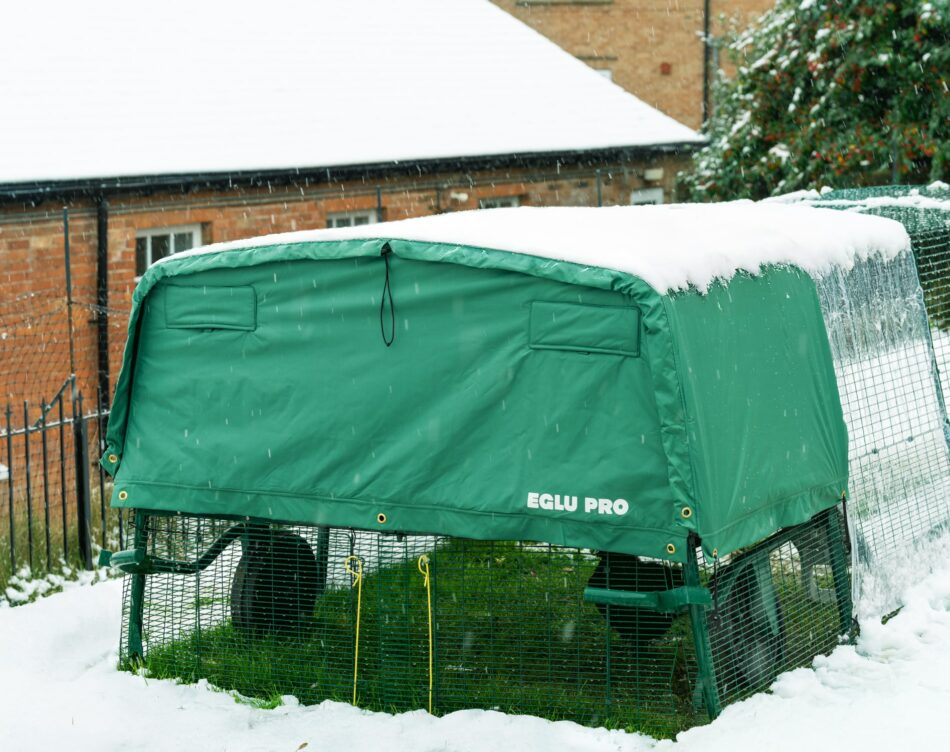
Omlet and your flock
When winter rolls in, you want your flock to feel safe, snug, and right at home, and that’s where Omlet comes in. With our insulated Eglu Chicken Coops and clever weather protection covers, you’ll have everything you need to keep your chickens warm and happy, no matter how frosty it gets. Our thoughtfully designed products make winter chicken care simple and stress-free, so you can spend more time enjoying your flock and less time worrying about the cold.
This entry was posted in Chickens
For any animal living outdoors, winter is likely to be the most challenging time of year, and your chickens are no exception. The days are shorter, there aren’t as many bugs and plants to peck at, and the people they enjoy following around the garden tend to spend less time outside because of the cold weather.
But don’t worry, you can help your feathered friends stay happy, healthy and entertained by stepping in with creative solutions. When your chickens get bored, they might start pecking at their friends or even eating feathers and eggs. That’s why it’s so important for you to ensure that your flock has plenty of stimulation and fun in their run until warmer weather and longer days return.
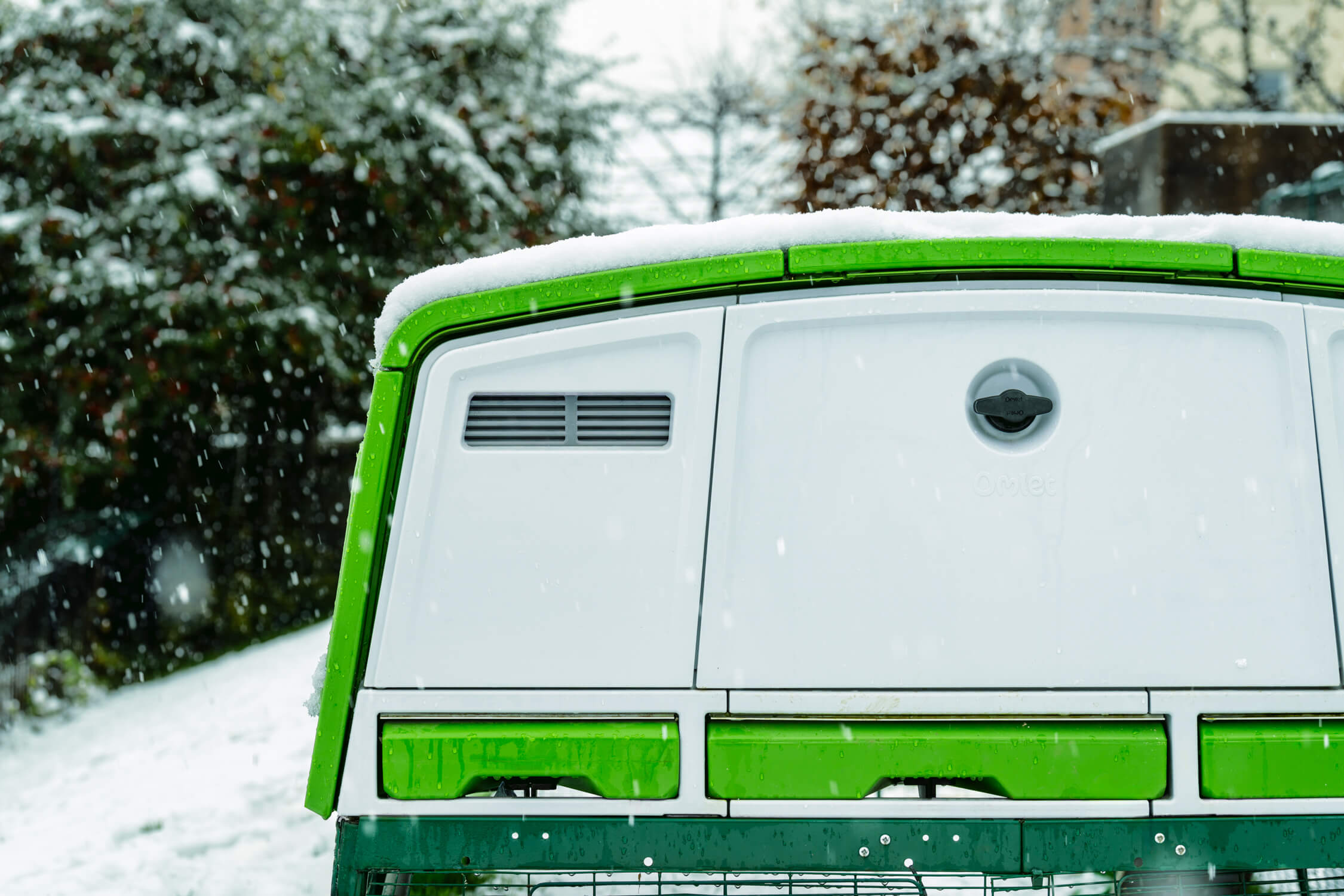
Weatherproof chicken coops keep hens warm and dry
The most important thing to get right for your chickens in winter is their environment, starting with the coop. Wooden chicken coops absorb moisture and without regular maintenance and repairs, can become drafty, damp and rotten quickly in winter. When paired with poor ventilation and insulation, hens are vulnerable to frostbite and respiratory problems.
Before winter sets in, take the time to complete repairs and winterproofing on your wooden coop, or upgrade to something much more suited to cold temperatures, like an Omlet Eglu plastic chicken coop. Here’s why you and your hens will love an Eglu in winter:
- Waterproof panels – keep out rain and snow, don’t absorb moisture and keep hens dry
- Twin-wall insulation – works like a coffee flask to retain your hens’ body heat inside the coop
- Purposeful ventilation – engineered to keep air inside the coop fresh without drafts, preventing moisture build up and respirator issues
- Quick to clean in 5 minutes – makes it easy for you to maintain optimal hygiene for your hens, even in winter
Chicken perches provide winter entertainment
Enrich your hens’ environment for winter with perches. Perching is not only relaxing but also a stimulating activity for chickens. By offering perches at different heights in the run, you provide your feathered friends with exciting opportunities to relax and explore. Perches also enable chickens to step up off the cold icy ground.
This Chicken Perch, available in 3ft or 6ft lengths, can be easily installed anywhere on any chicken run. You can add as many perches as you like to keep your chickens engaged. Just make sure there is enough space for everyone to perch comfortably, and adjust the perch height to suit the age and abilities of your hens.
Chicken runs offer more room to roam
Sometimes a little extra space goes a long way. By giving your chickens a larger area to move around in, you encourage them to exercise and explore more. If you’re unable to let your flock free range, providing them with a bigger run is essential. The Omlet Walk In Chicken Run can be tailored to the space you have, and keeps your hens safe from predators while offering ample room to roam. Be sure to wrap your run with clear chicken run covers for winter to protect your hens from wind, rain and snow, while still letting sunlight in.
If you already have an Omlet Walk In Chicken Run, remember that you can always extend it with easy-to-add panels. Use the handy extension configurator to explore how to expand your run even further.
Straw and hay bales provide a fun challenge
Have you ever noticed how your hens go wild when they encounter a pile of leaves? They absolutely love demolishing anything they can get their beaks on, always on the lookout for tasty bugs and seeds. Place an appropriately sized bale in the run, and you’ll see your chickens immediately jump on top of it, eagerly pecking away and enjoying the challenge.
Chicken toys offer enrichment
Just like with dogs and small children, the right toys can keep your hens happily occupied for hours. Chicken Peck Toys are designed to release treats slowly, scattering goodies, corn, or grit as your chickens peck them. Omlet’s Poppy Peck Toy is pressed into the ground and shakes corn free with each peck, whereas the Pendant can be hung from the run or another structure, adding fun dynamic movement.
Consider giving your flock a couple of peck toys to ensure that every member gets a chance to play and have fun, this way you minimize the risk of only the dominant chickens enjoying all the treats.
Extra feed gives your chickens energy to keep warm
Chickens need to eat up to 50% more feed a day in winter as they burn more calories to maintain their core body temperature in cold weather. While it’s important to keep your chickens’ diet balanced, you can also give them some extra high-protein treats too. Occasionally offering seasonal fruits or veggies not only helps keep your hens warm but also engages their minds and bodies with a tasty challenge. You can use dispensers like Omlet’s Caddi Chicken Treat Holder to serve these delicacies and keep the run floor clean.
An insulated waterer will prevent freezing in cold temperatures
Keep a close eye on your chickens’ water during winter as freezing temperatures can quickly turn it to ice. If you’re fed up of repeatedly having to break the ice in your chicken’s water, consider an insulated chicken waterer. The Omlet nipple waterer is engineered for extreme temperatures, with thick insulated walls to stop the freezing temperatures outside from reducing the water temperature inside so your flock always has fresh flowing water to drink.
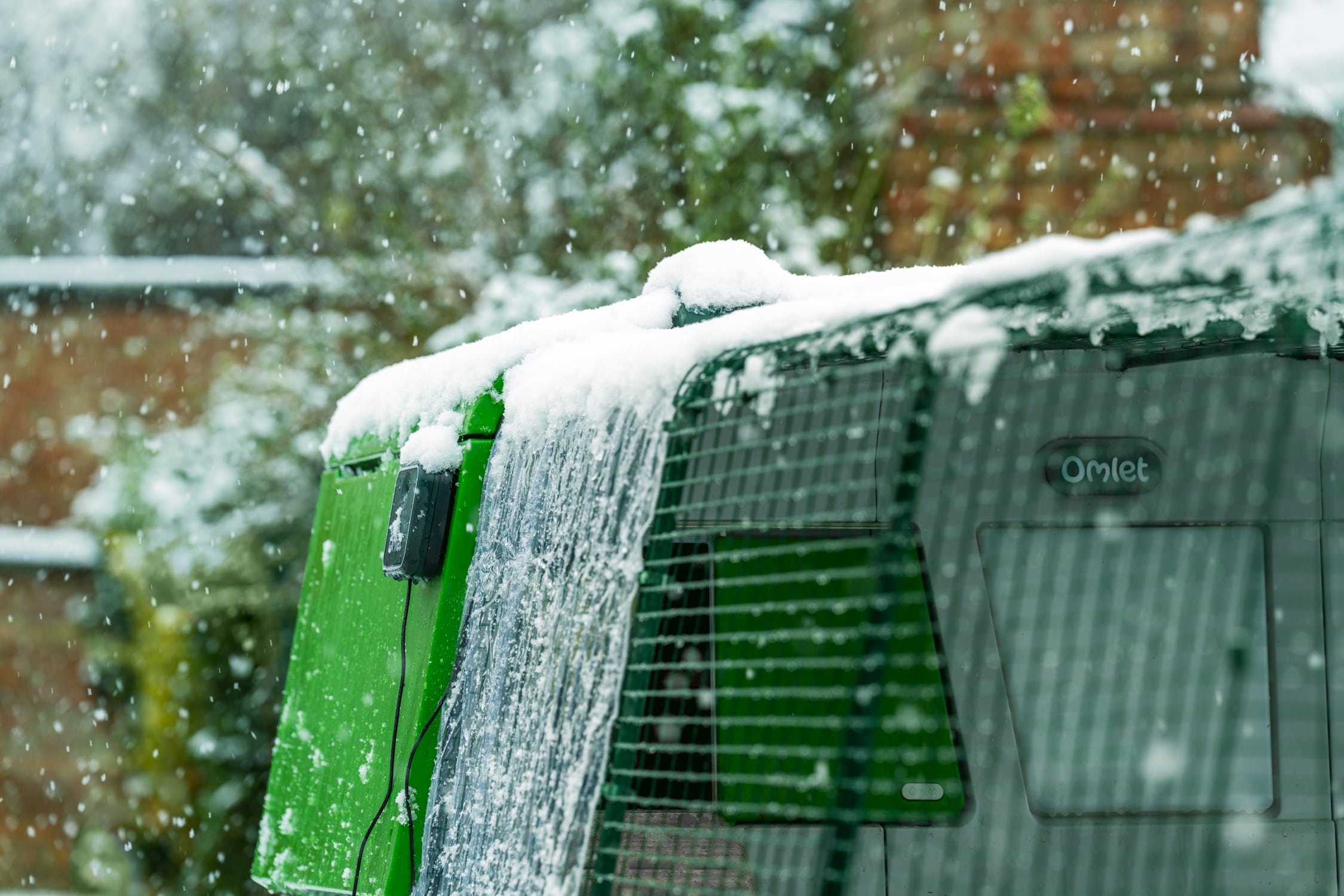
Omlet and your flock
Keeping your chickens happy and healthy this winter is a breeze with a little extra care and the right Omlet essentials. Simple steps can make a big difference – helping your flock stay warm, active, and full of life, no matter how chilly it gets outside. With the right weatherproof chicken coop, an insulated chicken waterer, and fun toys and perches designed just for your hens, you can relax knowing your chickens are safe, comfortable, and ready to enjoy winter.

This entry was posted in Chickens
As the days grow shorter and the temperatures drop, many of us adjust our routines to accommodate the colder weather—whether it’s layering up before a walk or swapping iced coffee for something warm. But what about our pets? Winter can be just as challenging for them as it is for us. With a little creativity and the right tools, you can help your furry friends stay happy, healthy, and cozy all season long.
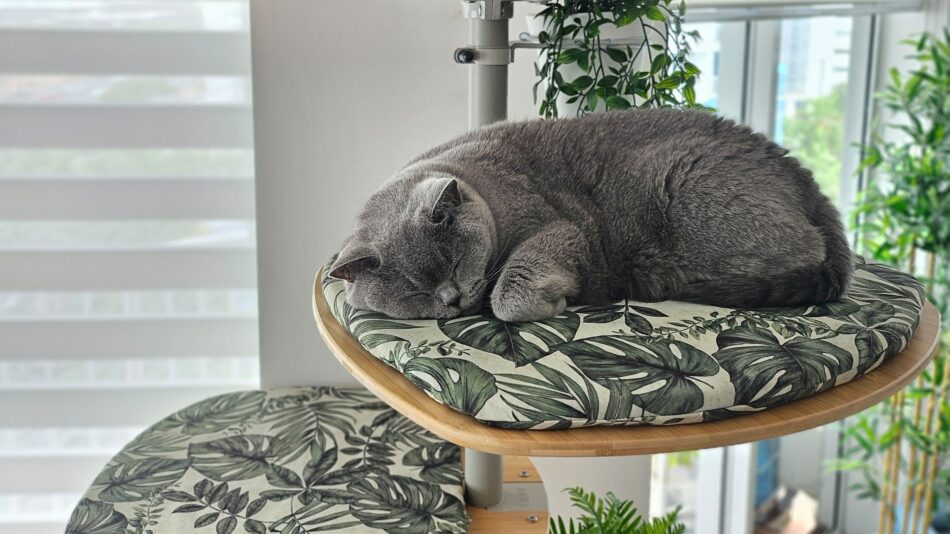
Get moving indoors
Cold weather and icy conditions can make outdoor activities less appealing, but keeping your pets active is essential for their physical and mental well-being. For dogs, bring the fun inside by creating an agility course using household items like chairs and blankets. Hide-and-seek is another great option—hide treats or a favorite toy and let your dog sniff them out. If your dog is high-energy, consider tug-of-war games or fetch in a long hallway or basement. These indoor activities not only keep your pup moving but also help to burn off excess energy when outdoor time is limited.
Cats, too, need to stay active during the colder months. Winter is a great time to introduce new interactive toys, like wand teasers or laser pointers, to keep them engaged. Products like the Freestyle Indoor Cat Tree designed by Omlet can transform your home into a feline playground, offering vertical spaces for climbing and scratching. If your cat enjoys hunting-style play, try puzzle feeders or treat-dispensing toys to stimulate their natural instincts. These small changes can go a long way in keeping your pets happy and healthy through the season.
Winter-proof your walks
Winter walks can still be a highlight of your dog’s day if you’re prepared. Start with proper gear—invest in a warm, waterproof coat to protect your dog from the chill, especially if they have short fur. Paw balm or boots are also great options to shield sensitive paw pads from icy sidewalks and salt. Adjust your usual route to include paths that are clear of snow or ice and aim for daylight walks when temperatures are at their peak. Remember, shorter walks are fine when the weather is harsh, so long as you make up for it with indoor activities.
Cats aren’t typically fans of winter adventures, but some indoor/outdoor cats may still want to explore. Keep an eye on the weather and limit outdoor time to prevent exposure to extreme cold. Consider setting up an outdoor Catio for brief outdoor breaks where your cat can enjoy the sounds and feels of nature. For cats who love window-watching, a warm perch near a sunny spot can offer hours of entertainment. Whether they’re indoor or outdoor, ensuring your pets stay safe and comfortable is key during the colder months.
Create a cozy retreat
Winter is all about creating comfort, and your pets deserve a space where they can retreat from the cold. For dogs, a cozy bed placed away from drafts is a must. Omlet’s Bolster Dog Bed offers ultimate comfort, with plush cushioning to support your pup’s rest. You can also add a soft blanket or heated pad for extra warmth. If your dog enjoys being close to the action, consider setting up their bed in the living room so they can relax while staying near you.
Cats are masters of finding the coziest spots in the house, but you can make their winter even more enjoyable by enhancing their favorite nooks. Heated beds or self-warming mats are perfect for keeping them snug in their favorite cat bed. A sunny window perch with a padded cushion can provide a cozy spot to lounge and soak up natural warmth. Don’t forget to ensure their litter box and feeding areas are in warm, draft-free locations to keep them comfortable all season long.
Engage the senses with enrichment
Mental stimulation is just as important as physical activity, especially when your pets are spending more time indoors. For dogs, puzzle toys and treat-dispensing balls can turn mealtime into an engaging activity. Rotating their toys every week can also keep things fresh and exciting. If your dog enjoys learning, winter is an excellent time to teach new tricks or practice basic obedience skills—both are great ways to bond and stimulate their mind.
Cats thrive on variety and challenge, making winter the perfect time to try new enrichment tools. A scratching post like the Switch LED Scratching Post designed by Omlet can provide hours of entertainment and encourage healthy scratching habits. Interactive toys, like battery-operated mice or wand teasers, can mimic the thrill of a hunt. For extra fun, create a simple DIY activity using a cardboard box with cutouts for them to bat at dangling toys or hidden treats. These activities not only keep your pets entertained but also prevent winter boredom.
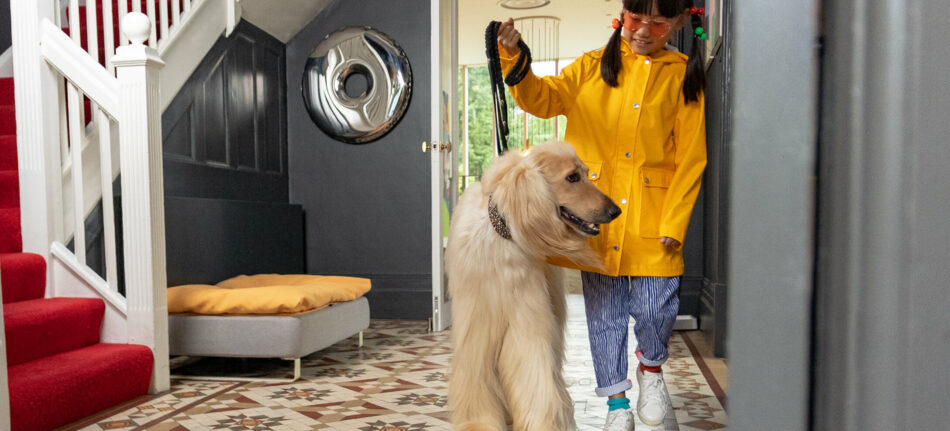
Stick to a seasonal schedule
Winter’s shorter days can disrupt your pet’s usual rhythm, so maintaining a consistent schedule is essential. Feed your pets at the same time each day and stick to regular play and rest periods. For dogs, this might mean planning walks and indoor play sessions around your work schedule to ensure they get enough activity. Sticking to routines provides a sense of security and helps reduce stress during seasonal changes.
Cats, with their naturally structured habits, also benefit from a winter routine. Schedule playtime before meals to simulate their natural hunting instincts, followed by plenty of opportunities for rest. Keep mealtimes consistent and ensure their favorite cozy spots are ready for long naps. By sticking to a predictable schedule, you can help your pets adapt seamlessly to the colder months.
Let winter inspire new traditions
Winter is the perfect season to slow down and spend quality time with your pets. For dogs, start a weekly “cozy night in” tradition with snuggles on the couch and a few extra treats. You could also use this time to create a special grooming ritual, like brushing their coat or trimming their nails, which not only strengthens your bond but keeps them looking and feeling their best.
Cats might prefer a different kind of bonding—think quiet evenings filled with gentle petting or interactive play sessions. Winter is also a great time to introduce new experiences, like a cat-safe blanket fort for them to explore. These seasonal traditions aren’t just about keeping your pets entertained—they’re an opportunity to celebrate the love and companionship that make them such a special part of your family.
Omlet and your pet
At Omlet, we understand that winter brings unique challenges for pets and their owners, which is why we approach our designs with the same curiosity and care that pets bring to the world around them. From cozy dog beds that keep your pup warm to interactive cat scratchers that banish boredom, our products are crafted to help your furry friends thrive during the colder months. By asking the right questions and celebrating the bond you share with your pets, Omlet creates solutions that make winter a season of comfort, joy, and connection.
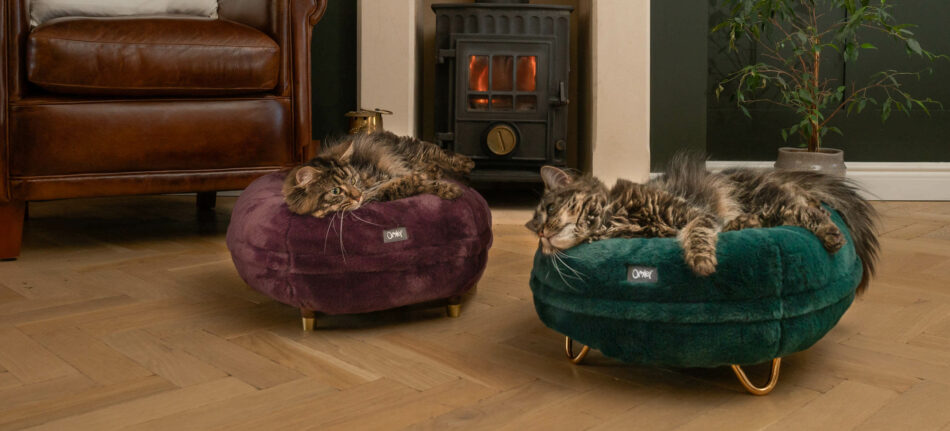

This entry was posted in Pets
Izy Hossack is a London based chef and baker, food stylist and food photographer, as well as author of the books Top with Cinnamon and The Savvy Cook. Izy has created two deliciously festive recipes for the Omlet Advent Calendar, you can find her Chocolate Gingerbread Bundt Cake here.
This layer cake is the perfect Christmassy bake to impress. Inspired by the flavors of eggnog, the cake and frosting are flavored with vanilla, nutmeg, cinnamon and rum for a slightly boozy, warmly spiced dessert.
The frosting is an interesting one to try – if you usually find standard buttercream too sweet, you’ll love this version (and it doesn’t require icing sugar!). The base is a cooked custard, thickened with corn flour and egg until very viscous. This is then whisked into softened butter until fluffy and creamy. It can seem a bit dense if the butter or custard are too cold so you may need to add a little bit of boiling water to help it fluff up properly. It’s definitely worth the extra effort over a standard buttercream as the texture is so smooth and light with the perfect level of sweetness.
For decoration, I like to keep the frosting simple with a thin layer around the outside and a slightly swoopy texture on top. For the toppings, I look for edible bits to give the cake a festive look; Woody herbs like rosemary, thyme or sage (as I’ve used here) are lovely as are chopped/flaked nuts. A sprinkle of cinnamon and nutmeg are a finishing touch and boost that eggnog flavor.
Ingredients:
Cake:
300g granulated sugar
140g unsalted butter, softened
60ml vegetable oil
4 medium eggs
150ml natural yogurt
150ml milk
1 tsp vanilla paste or extract
330g self-rising flour
1 tsp ground cinnamon
¼ tsp freshly grated nutmeg
¼ tsp fine table salt
¼ tsp baking soda
Frosting:
150ml milk
1 tsp vanilla paste or extract
80g granulated sugar
20g corn flour
1 egg
½ tsp ground cinnamon
¼ tsp freshly grated nutmeg
Pinch salt
200g unsalted butter, softened
2 tbsp dark rum
For the cake:
- Preheat the oven to 350 degrees Fahrenheit. Grease, line and flour three 18-cm cake tins.
- In a large bowl, cream the sugar and butter until pale and fluffy. Beat in the oil then eggs, one at a time.
- In a jug, combine the yoghurt, milk and vanilla.
- In a separate bowl, place the flour, cinnamon, nutmeg, salt and bicarbonate of soda and stir to combine.
- Add 1/3 of the yogurt mixture to the butter mixture and stir to combine. Add 1/3 of the flour mixture to the butter mixture and stir to combine. Repeat in this alternating fashion until you’ve mixed in all of the yoghurt and flour mixtures and have a smooth cake batter.
- Divide the batter evenly between the cake tins and bake for 25-30 minutes, until a skewer inserted into the center of the cakes comes out clean.
- Run a butter knife around the inside edges of the cake tins and then leave them to cool for 10 minutes before turning out onto a wire rack to cool completely.
For the frosting:
- Combine the milk and vanilla in a small pot and place over a medium-low heat on the stove until gently steaming.
- In a medium bowl, mix the sugar, corn flour, egg, cinnamon, nutmeg and salt until smooth.
- Pour a little of the hot milk into the egg mixture and quickly stir with a whisk until smooth. Stream in the remaining hot milk whilst stirring to combine. Pour the contents of the bowl back into the pot and return to the heat.
- Cook over a medium-low heat, stirring with a whisk, until the mixture becomes lumpy and thick. Keep stirring until it looks smooth and glossy, about 1 minute, then remove from the heat.
- Spread the mixture out in a shallow bowl and pop into the freezer for 5-10 minutes until cooled. Alternatively, chill the mixture in the fridge for around 1 hour.
- Beat the softened butter in a large bowl with an electric whisk (or in a stand mixer) until smooth then gradually add the cooled egg mixture, stopping to scrape down the sides and bottom of the bowl occasionally.
- Add the rum and keep whisking until the frosting looks aerated and light. If it seems too dense still, add 1-2 tbsp of boiling water to help soften the butter which should help the frosting to achieve the correct texture.
To assemble:
- Cut off any domed tops from the cooled cake layers using a serrated knife and peel away the baking paper from the bottoms.
- Place one cake layer onto a serving plate and spread a few heaped tablespoons of frosting over the top of the cake. Top with a second cake layer and repeat.
- When you’ve placed on the final cake layer, place ½ of the remaining frosting onto the cake and spread it thinly over the top and sides of the cake. Using a warm palette knife can be useful here (warm it up by placing into a jug of boiling water and wipe clean as needed).
- Place the cake into the fridge for 10 minutes to harden this initial layer of frosting.
- Remove the cake from the fridge and add the remaining frosting to the cake, using it to decoratively frost the top and sides as you like.
- Decorate the cake with any toppings you want – I’ve used grated nutmeg, ground cinnamon, sage leaves and flaked almonds here for a festive feel.
This entry was posted in Food
Izy Hossack is a London based chef and baker, food stylist and food photographer, as well as author of the books Top with Cinnamon and The Savvy Cook. Izy has created two deliciously festive recipes for the Omlet Advent Calendar, starting with this Chocolate Gingerbread Bundt Cake, perfect for the Christmas party!
Ginger and chocolate make the perfect combination in this festive Bundt cake. The batter is very easy to make as it’s a melt-and-mix situation, so no electric mixer is required! The golden syrup and treacle bring a soft, squidgy texture and boost the warming flavors of the spices. The ganache is best made with a bitter chocolate as this helps to tame the sweetness of the cake. For a pretty (and delicious) decoration, a simple sprinkle of crystallized ginger chunks is the perfect touch – you can find them in the baking aisle of most large supermarkets.
Ingredients:
175g unsalted butter, plus a couple of tablespoons for the tin
150g golden syrup
120g treacle
120g light brown sugar
3 medium eggs
200g natural yogurt
250g plain white flour
60g cocoa powder, plus more for the tin
1 ½ tsp bicarbonate of soda
1 ½ tsp ground ginger
1 tsp ground cinnamon
¼ tsp fine table salt
Ganache:
100g dark chocolate (70% cocoa content)
100ml double cream
3 tbsp crystallized ginger chunks
To prepare the tin:
- Place a standard Bundt tin into the freezer for 5-10 minutes. Melt a couple of tablespoons of butter in a medium pot (we’ll use this pot later for the batter too) over a low heat.
- Generously brush the inside of the Bundt tin with the melted butter, making sure you get into all of the crevices.
- Dust the tin with cocoa powder, tapping it around the tin to coat all over then tip out any excess (if you collect it on a plate, you can use the excess cocoa powder in the cake batter).
For the cake:
- Preheat the oven to 350 degrees Fahrenheit.
- Take the same pot you were using earlier and add the 175g of butter, the golden syrup, treacle and light brown sugar. Place over a low heat on the stove and cook, stirring often, until the butter has fully melted. Remove from the heat and allow to cool for a few minutes.
- To the cooled butter mixture, stir in the eggs one at a time, then stir in the yoghurt.
- In a large bowl, mix the flour, cocoa powder, bicarbonate of soda, ginger, cinnamon and salt.
- Pour the wet mixture into the dry mixture and stir with a whisk until smooth.
- Pour the batter into the prepared tin and bake for 40-50 minutes, until a toothpick inserted into the center of the cake comes out clean.
- Allow the cake to cool for 10 minutes in the tin before tipping out onto a cooling rack.
For the ganache:
- Place the chocolate into a small, heatproof bowl. Pour cream into a small pot and place over a medium-low heat. Once the cream is gently steaming, remove from the heat and pour over the chocolate in the bowl.
- Allow to sit for 10 minutes then stir to get a smooth ganache.
- Drizzle the ganache over the cake (which can still be warm when you do this) allowing it to drip down the sides. Decorate with crystallized ginger while the ganache is still warm.
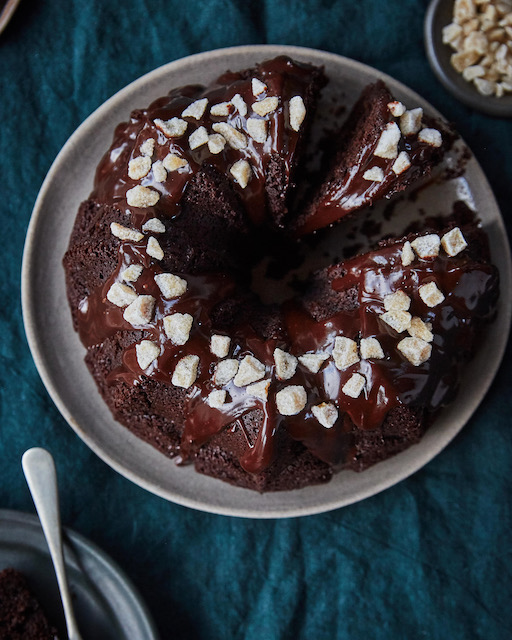
This entry was posted in Food
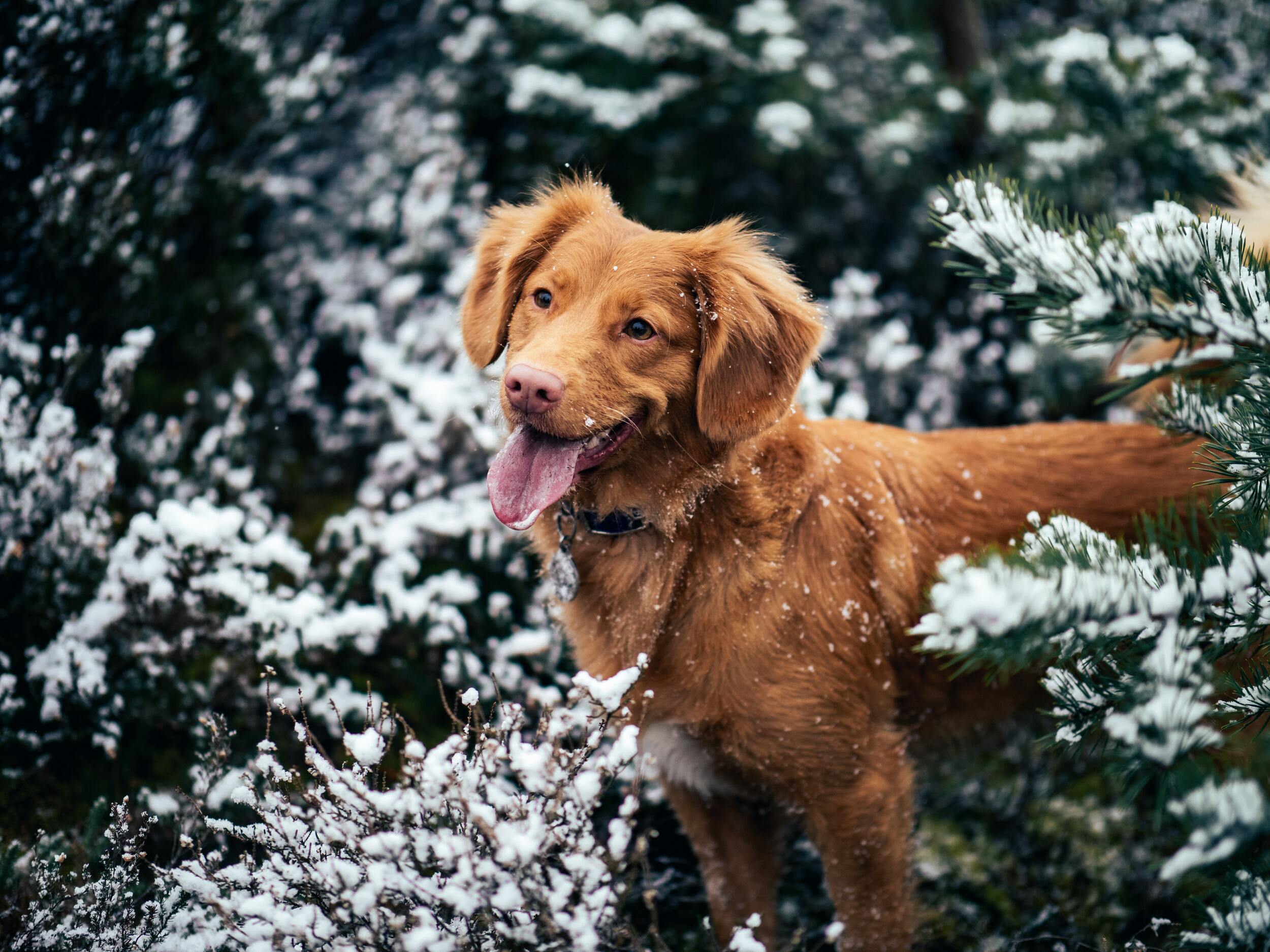
Photo by Jamie Street on Unsplash
Some dogs love rolling in the snow, while others are happy to sit out the cold weather in the comfort of a centrally heated house. For the snow-lovers, thick fur is definitely an asset. Breeds such as Siberian Huskies and Alaskan Malamutes, bred for life and hard work in cold climates, will have no problems at all with the average Winter temperatures.
Hardy breeds with thick coats, such as German shepherds, Poodles and Golden retrievers, will love their cold weather walks, too. Thin coated breeds such as Greyhounds and Whippets, and small dogs such as Chihuahuas and Yorkies need to be protected from the cold. Puppies, older dogs, and ill dogs may need extra care in the Winter, too.
Whatever the breed, never leave it outside in very cold weather, as even a hardy dog can succumb to the chill if its body temperature gets too low.
How do you know if it’s too cold for your dog?
You will soon be able to tell if your dog is feeling the cold, as it will simply tell you! Dogs will be reluctant to go on a walk or will not be as active as usual during the walk, sitting down in a sheltered spot or walking much more slowly than usual. Cold dogs may become anxious, whining and walking by your side, looking at you pleadingly. Smaller dogs will begin to shiver very quickly in the cold, and even larger breeds may shiver after a while. If there is snow underfoot, a dog may limp if it feels uncomfortable with the ice in its toes.
It will not often come to this, though – certainly not in healthy dogs. They will do so much running that they will not feel the cold unless the snow itself becomes a problem in their fur or between their toes.
How cold is too cold for a dog?
Generally, 45°F is a minimum temperature, at or above which all dogs will be comfortable. As the temperature dips towards 32°F, less hardy dogs will need to wear a dog sweater or coat. In extreme cold, all breeds other than those super-hardy Huskies, Malamutes, Samoyeds and Newfoundlands are in danger of becoming too cold.
How do you know if your dog needs a coat?
The question of whether it is too cold for your dog is largely down to breed and is also influenced by the age and health of your pet.
Dogs with fine hair and/or thin body types (e.g. Greyhounds) will need to wear a coat outside when the temperature dips. If there is snow on the ground, small dogs and puppies will need a coat during walks or playtime in the park. Being small, they become cold quicker than larger dogs, and their undersides get cold quickly too, simply because their bellies are closer to the ground.
Older dogs and young puppies have relatively weak immune systems and can become ill if they get too cold. Old dogs with arthritis suffer in cold weather, too, and may even require a coat indoors during the winter to ease their sore joints.
Lighter-furred dogs may benefit from a dark coat to soak up a bit of Winter sun heat. If the wind is strong and icy, a coat can make things much more comfortable for any breed (with the exception of the dogs bred for harsh conditions).
Even a hardy dog can become very uncomfortable in the snow, as their fur may accumulate the frozen stuff. Dogs will instinctively try to clear their snowed-up muzzles and heads by rubbing them on the ground – thus gathering even more snow! A dog’s toes can get iced up to, which is clearly uncomfortable for them.
The snow can be removed periodically during the walk (although it will sometimes form ice and cannot be immediately removed). A good thaw-out back home will cure the problem, though.
How to keep your dog warm throughout the Winter
Knowing your own dog’s needs is key to knowing if the dog is too cold. Dogs do not need to be cozy/warm at all times, and you may have noticed how they will sometimes seek out a cool part of the floor to lie down on, especially when the central heating is switched on in the Winter. It is a fact that overheating is, in general, more of an issue than feeling the cold.
Dark-furred breeds benefit from Winter sun, being able to absorb what little heat there might be in the sun. Lighter colors reflect the light, and the heat too.
If your dog needs a coat in the cold, that’s a simple remedy against the Winter chills. A cozy bed is important, too, to keep your dog warm at night.
Avoiding severe doggie haircuts in the Winter is a good idea, as a drastic trim is not going to help in the battle against the cold!
How do I know if my dog is too cold at night?
As long as your dog has a soft bed to lie on, and as long as the room temperature remains above freezing, dogs are unlikely to get too cold. The dog will curl up and snuggle down, its own body heat sufficient for a good night’s sleep.
Making sure you have a dog bed that’s fit for every season is important. It doesn’t get much better for dog when they have a cozy bed to relax in after a long Winter Day. A bed that can be raised off the ground, to improve ventilation and prevent the bed from becoming too hot on a warm floor or too cold on a chilly one will benefit your dog .
.
A high-quality dog blanket can help, too – especially if your dog has a kennel or crate outside. Your dog will snuggle under it, or push it aside, just as you might do with a quilt, helping to keep the perfect temperature throughout the night.
Note: only very hardy breeds can cope with an outdoor crate or kennel in the Winter, even if it is fully weatherproofed.
What happens if dogs get too cold?
The main signs that your dog is too cold are shivering and whimpering. A dog who is shivering should be wrapped in a blanket and taken somewhere warm as soon as possible. That will usually do the trick.
If a frail or small dog is too cold, it can become ill. The cold lowers their immunity, giving diseases the chance to gain a foothold. If, during cold weather, your dog is constantly sneezing or has discharge from the eyes and/or nose, it could be a sign of dog cold or dog flu, canine influenza or other illnesses.
Dogs with hypothermia
Although highly unusual, it is possible for a dog to suffer hypothermia. This is when its body temperature has fallen from the normal range of around 101°F to 102.5°F to (99°F) or lower. Such a plummet in temperature can prove fatal, even if you manage to get your dog quickly back to a warm spot.
You can tell if your dog has hypothermia, or is in danger of succumbing, by watching how it behaves. The symptoms include lethargy or sleepiness, clumsy movements, stiff limbs or breathing difficulties.
Prevention is the only remedy here. Know your dog, know their physical limitations, and use your judgement to prevent putting the dog in an environment that might mean your dog is too cold and could thus lead to hypothermia.
Dogs with frost bite
Frostbite is another cold weather risk. In extreme cold, a warm-blooded animal’s body protects its vital organs, redirecting blood flow there. This means that extremities such as ears, noses, tails and paws are at risk of freezing. If any of those parts of the body is bright red or black, your dog could be suffering from frostbite and should be warmed up immediately.
If your dog’s ears or tail feel ‘like ice’ when you hold them, it’s probably time to cut the walk short and head indoors.
In general, if you feel cold outside, in spite of your coat, hat and gloves, your dog will be feeling the cold pinch too. Common sense plays a big part when trying to tell if your dog is too cold in the Winter, and an animal as intelligent as a dog will certainly let you know if the cold weather is making it feel uncomfortable.
This entry was posted in Dogs
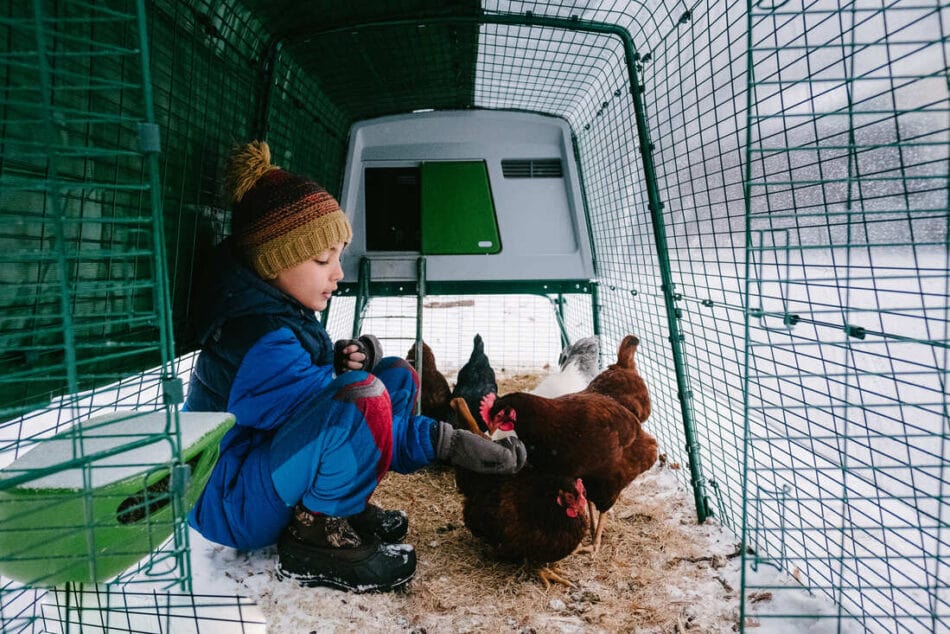
How cold is too cold for chickens? Chickens can tolerate cold weather, however, baby chicks are less likely to do so. The primary concern in cold temperatures is whether your chickens are becoming wet. If they are and cannot dry off, this can be cause for concern.
Our guide walks you through the optimum temperatures for chickens, how to care for your hens in winter, and which breeds are the most hardy.
How cold is too cold for chickens?
Chickens will regulate their temperature and behavior accordingly, so wherever humans can live, chickens can thrive too. Chickens can tolerate cold even under freezing temperatures. This makes caring for chickens in winter relatively simple, as only a few adjustments to your usual routine will need to be made. It is the combination of cold and wet that can prove fatal, so it’s vital to ensure your hens have a dry chicken coop. Any of your birds that become soaked should be toweled dry. Applying Vaseline to their combs will prevent frostbite and help them tolerate the cold.
Ideal temperatures for adult chickens
While chickens can tolerate the cold, their preferred weather is in the 70 degrees Fahrenheit range. You’ll find that your adult chickens can survive cold temperatures into the teens. However, we recommend keeping a thermometer in your coop to track its temperature. You should find that the insulation of your coop and the warmth created by the chickens themselves is enough to help them tolerate the cold.
Ideal temperatures for baby chicks
Baby chicks are far more sensitive to cold temperatures and are not able to tolerate them as well as full-grown hens. This is both due to their smaller size and the fact their feathers are not yet fully developed to keep them warm. When your chicks first hatch you should keep them at around 90-95 degrees Fahrenheit. After this you can reduce the temperature they’re kept at around 5 degrees a week until you get into the 70 – 75 Fahrenheit range.
Keep your chickens’ coop warm & cozy
The type of coop you have makes a big difference in how cold your chickens will tolerate. In really cold winters, a wooden coop with a drafty coop door can soon become damp and semi-frozen – not to mention very drafty. This dampness combined with the cold weather will make winter more difficult for be more tricky for your flock to tolerate.
On the other hand, a more robust state-of-the-art chicken coop such as the Eglu will keep out the cold and damp – enabling chickens to tolerate the cold weather after a busy day in their run. You’ll find that an Eglu will stay much warmer during the winter than a wooden coop. The temperature in the Eglu will remain moderate when all the hens are tucked in at night. Our Eglus are insulated by design, but if the winter becomes colder than usual you can easily add extreme weather protection to further insulate your coop.
You can help your backyard chickens keep warm in the frost and help them weather the cold by making sure the coop is clean and dry. Clear out any snow dragged in on the hens’ feet and keep an insulating layer of straw on the floor. Doing this will help your chickens to tolerate the colder weather. If you also insulate your chicken runs, there should still be some ventilation, to allow the gasses released from the birds’ droppings to escape.
An automatic door will help keep the living quarters cozy, too. It’s not advised to install a coop heater – even those rated for hen houses. Hens may get used to being overly warm all the time, which could be disastrous if the heater fails. Heat-pampered poultry can die of shock when introduced to lower temperatures, as they will not have become acclimated to tolerating the cold.
4 signs your chicken is too cold
When ensuring your chickens will tolerate the cold, it’s important to know the signs for when the weather may have made them uncomfortable. Here’s what to look out for:
- Ruffled feathers
- Perched off the ground
- One leg tucked up
- Wattles and combs are paler than usual
These are not signs of distress, and as long as the chicken is only having a brief rest, rather than staying hunkered up for the whole day, you don’t have to worry. If hens go off their feed, appear to be in shock, or have discolored (blue or black) combs, wattles or feet, it’s time to bring them inside to warm up slowly.
Keeping chickens dry in cold temperatures
While chickens can tolerate the cold, they should not be allowed to remain soaking wet. This is more dangerous than the outdoor temperature or the falling snow – and in extreme cases will result in hypothermia. Any affected hens will be stiff and cold to the touch, with their eyes wide and unblinking, or closed. If you find one of your chickens in this state, take them indoors and wrap them in a warm towel. When they recover, put them in a bedding-lined box in a warm spot for a few hours.
What happens if a chick gets too cold?
Chicks are less tolerant of the cold and are more susceptible to lower temperatures than adult chickens. If a young chicken has its full coat of feathers, it will be as tolerant of the cold as the older birds. Chicks, however, will need protection from the cold, and should be kept under an appropriate heat lamp. Any chick left to fend for itself in cold weather will die.
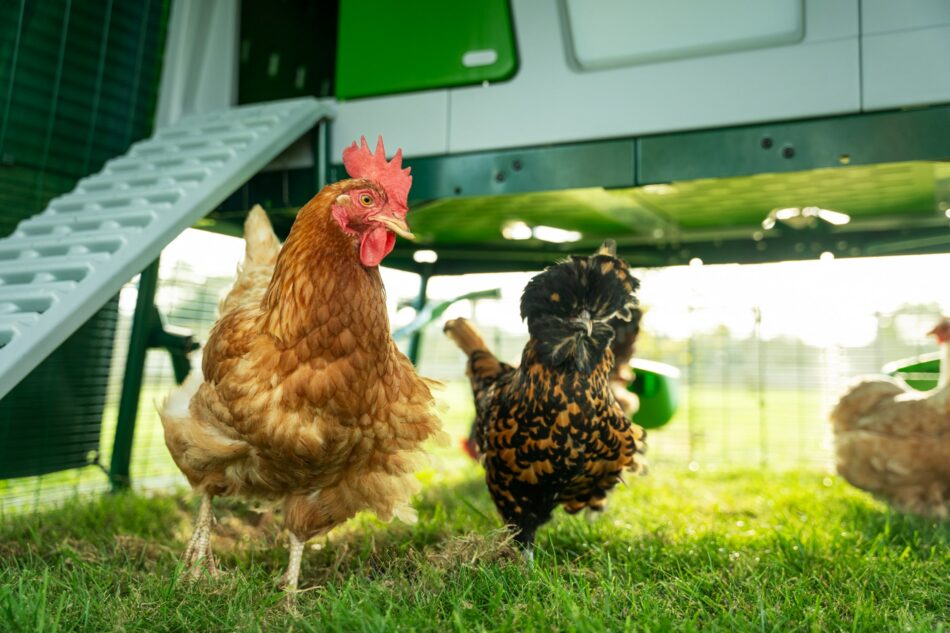
Tips for cold weather chicken care
Chickens can usually tolerate adapting to colder climates, but how can you tell when your flock needs a bit of help keeping warm? The following tips will help you keep happy, healthy chickens this winter:
- Prevent water from freezing – Check it at least twice a day to keep it clear of ice. If a freeze is forecast, bring the chicken waterers indoors at night. If possible, buy a water heater designed for the job of preventing freezing. Ping-pong balls in the water can also prevent freezing.
- Chickens usually return to the coop at dusk, but in the winter, you may find your birds trying to get more pecking time from the short days. If your hens tend to wander in the dark, a high visibility hen coat will help you locate them. The coats also keep the birds cozy, so it’s a double blessing in the Winter to help chickens tolerate the cold.
- Providing weather-proof shelter in the chicken run will give the hens some respite while tolerating the cold. You can use chicken run covers to do this.
- Some extra corn offered as a chicken treat before the hen’s bedtime will stoke their internal heater as the chickens digest it overnight. In general, hens will eat more food in the cold months to tolerate the cold, as more of their energy is spent keeping warm.
- Protect combs and wattles – from frostbite with petroleum jelly or Vaseline.
- Specially made coop heaters or brooder plates can be placed in enclosed spaces such as barns or garages for hens that are struggling in the cold, but should be used sparingly. And, these should only be used for a short amount of time, and only if someone will be home to avoid a potential fire-hazard.
- If you do not have a cozy Eglu, a wooden coop can be insulated with bubble-wrap, cardboard or old carpets or blankets.
- Extra bedding on the floor of the coop will help the chickens tolerate the cold, too.
- Some owners like to supplement their chickens’ diets with extra protein or a little suet, to increase their fat levels for the Winter. Fat retains heat, and the whole bird benefits from the added nutrition.
How do chickens naturally keep warm in the winter?
The chicken’s secret to tolerating the cold is natural insulation. Their feathers help them retain body heat and warm the air trapped beneath their downy base feathers. When they’re at rest, a hen’s body temperature is 104–107F, with their heart rate of around 400 beats per minute – evidence of a high metabolism that sets up the birds very well for winter weather.
Watching hens scratch at the frozen ground or strut through the snow, you might wonder how chickens manage to keep their feet and legs warm. After all, this is one part of their body with no feathers to keep it cozy (unless you happen to have a feathery-legged breed such as the Cochin, Brahma or Silkie). The answer lies in the chicken’s leg scales, which retain heat to a certain extent. The average chicken will always be on the move, not keeping all its toes on the ground for too long.
Does perching help chickens tolerate the cold?
Like many other birds, chickens often adopt the ‘one leg’ pose in the winter, tucking one of their limbs up into the warmth of their bellies. This reduces overall heat loss and stops feet and toes from freezing on the icy ground. Like all birds, chickens are warm-blooded, and their own body heat soon works its magic to help them tolerate the cold.
Perching is the most effective way for a chicken to retain body heat and tolerate the cold. Hens hunker down when roosting, with their feathers fluffed up and their legs tucked into her warm body. If space allows, install a flat perch in your coop or run. This will enable the hens to roost without having to curl their toes around the roosting bar, which will prevent their toes from freezing in very cold weather. An upturned pot, a log, pallet or other slightly elevated space will give the birds a flat surface to perch on, to escape the ice and snow.
Can chickens freeze to death?
Chickens can usually tolerate cold conditions and will not die, as long as they have a warm coop to retreat into when the weather becomes extreme. Cold hens may be more susceptible than usual to illness and parasites, though, and their egg production will fall. But, most chickens will simply hunker down on chicken perches and in nesting boxes, with their feathers fluffed out to weather the winter.
The best chicken breeds for cold weather
While most chickens can tolerate the cold, there are some chicken breeds that are more suited to cold climates than others. Here are the top 5 for cold temperatures:
Introducing Omlet pet care
Omlet can help you care for your chickens and ensure they’re enjoying each season to the fullest. From chicken pens to run around in, to toys such as chicken swings to keep them entertained, you’re sure to find everything you need to keep your flock healthy and happy all year round!
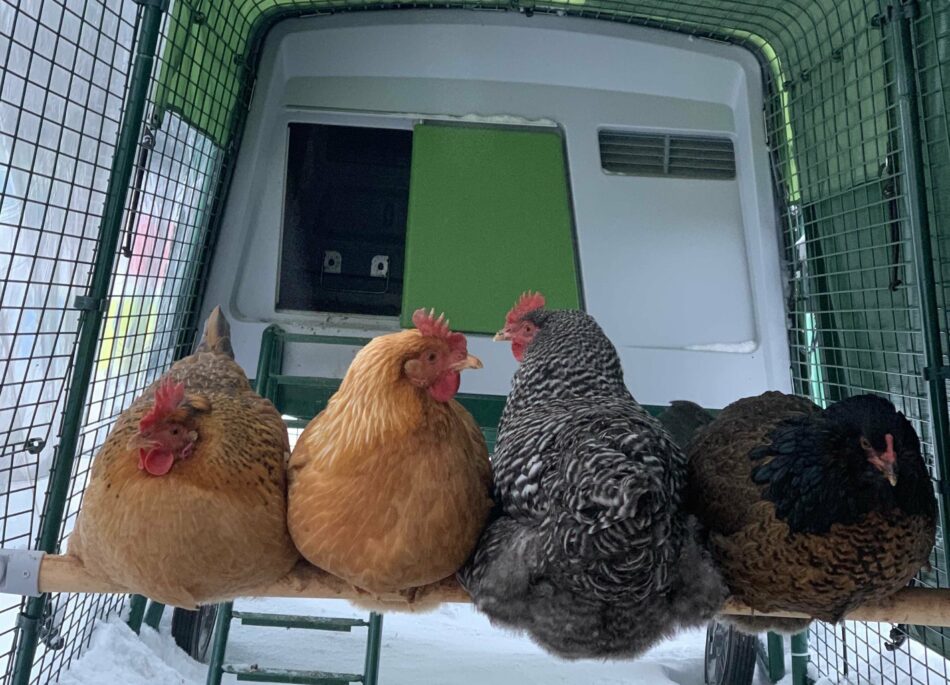
This entry was posted in Chickens
In December, Santa Barbara and her team of Elves helped us say a big thank you to our pets and all they have helped us through in the past year. We’ve been in touch with some of the lucky winners from around the world to see how their pets are enjoying their special prizes…
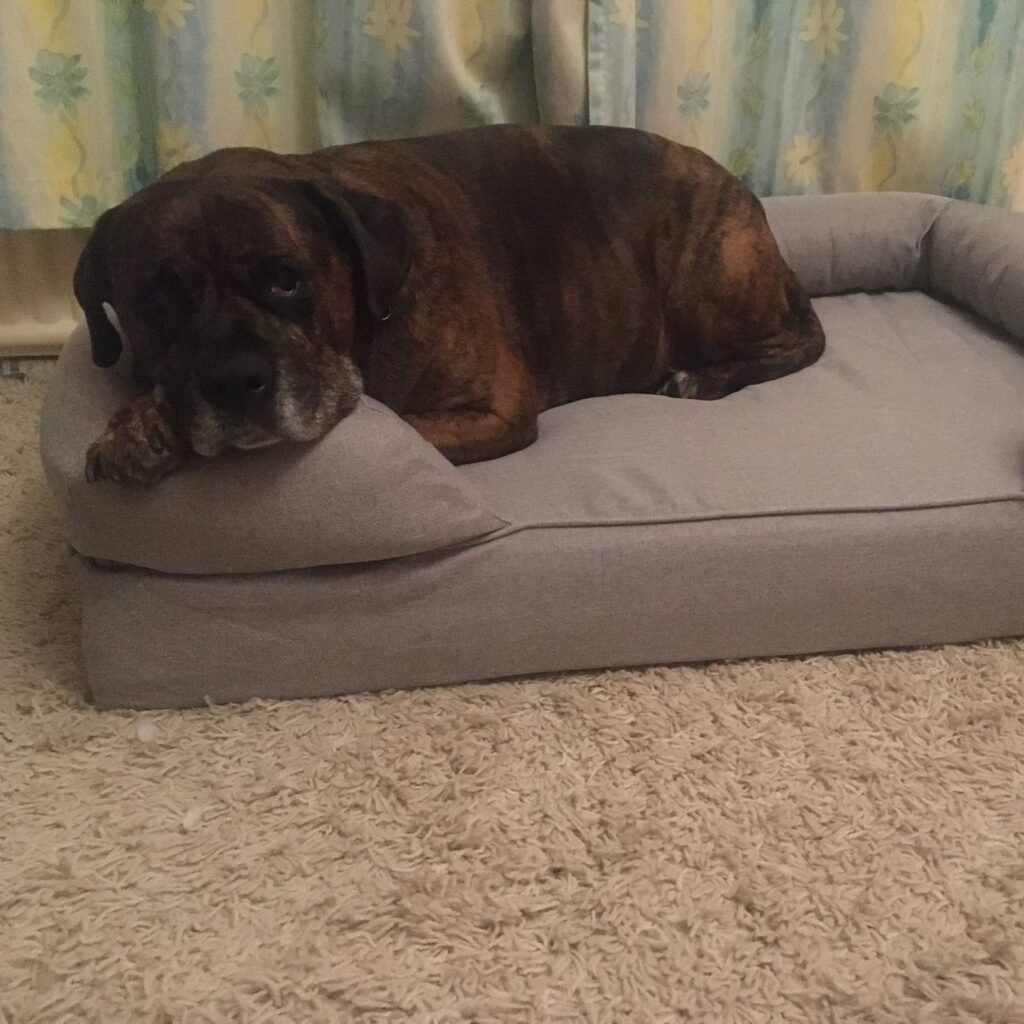
Bella had a super comfy Christmas in her new Bolster Bed – the perfect place to wind down from all the excitement and festivities!
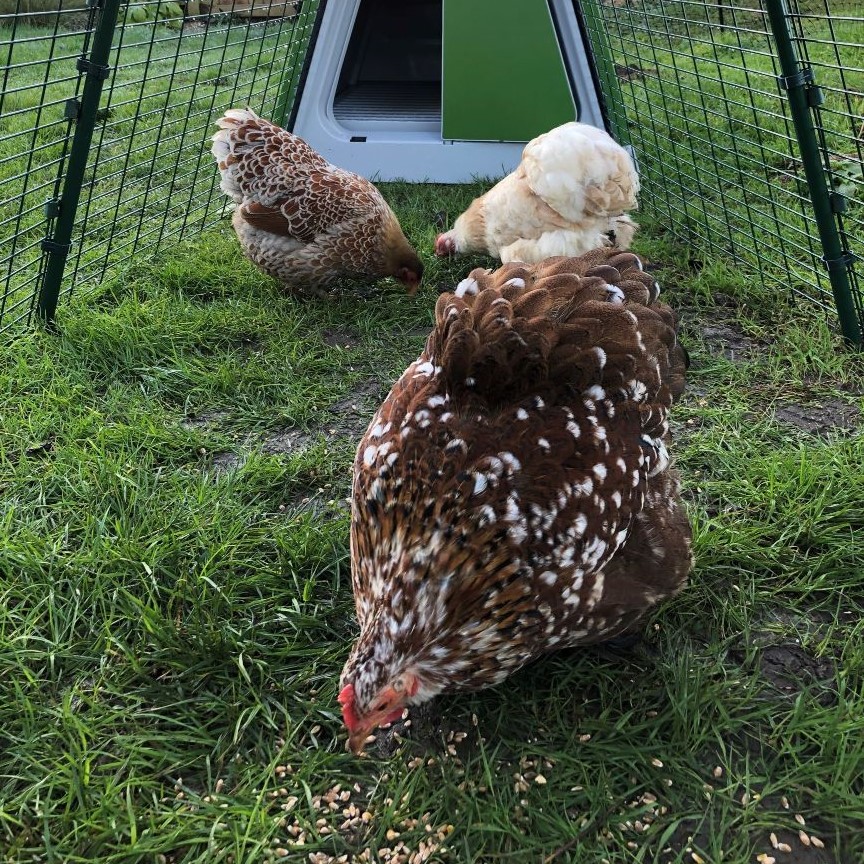
Princess Penny, Lady Henney and Madame Francis D’Borah have given their new Eglu holiday home the stamp of approval!
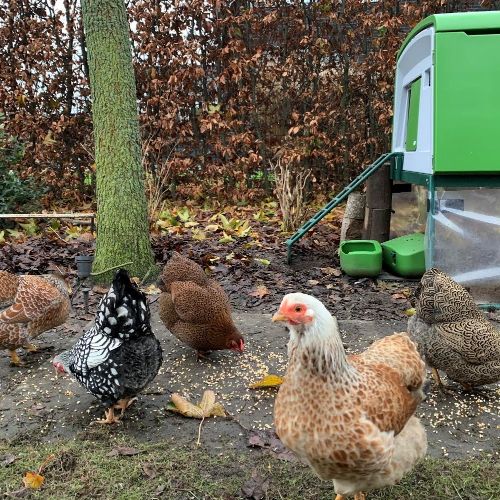
These 5 wyandottes moved from a wooden coop to the Cube in Summer, and now have the luxury of an Autodoor thanks to Santa!
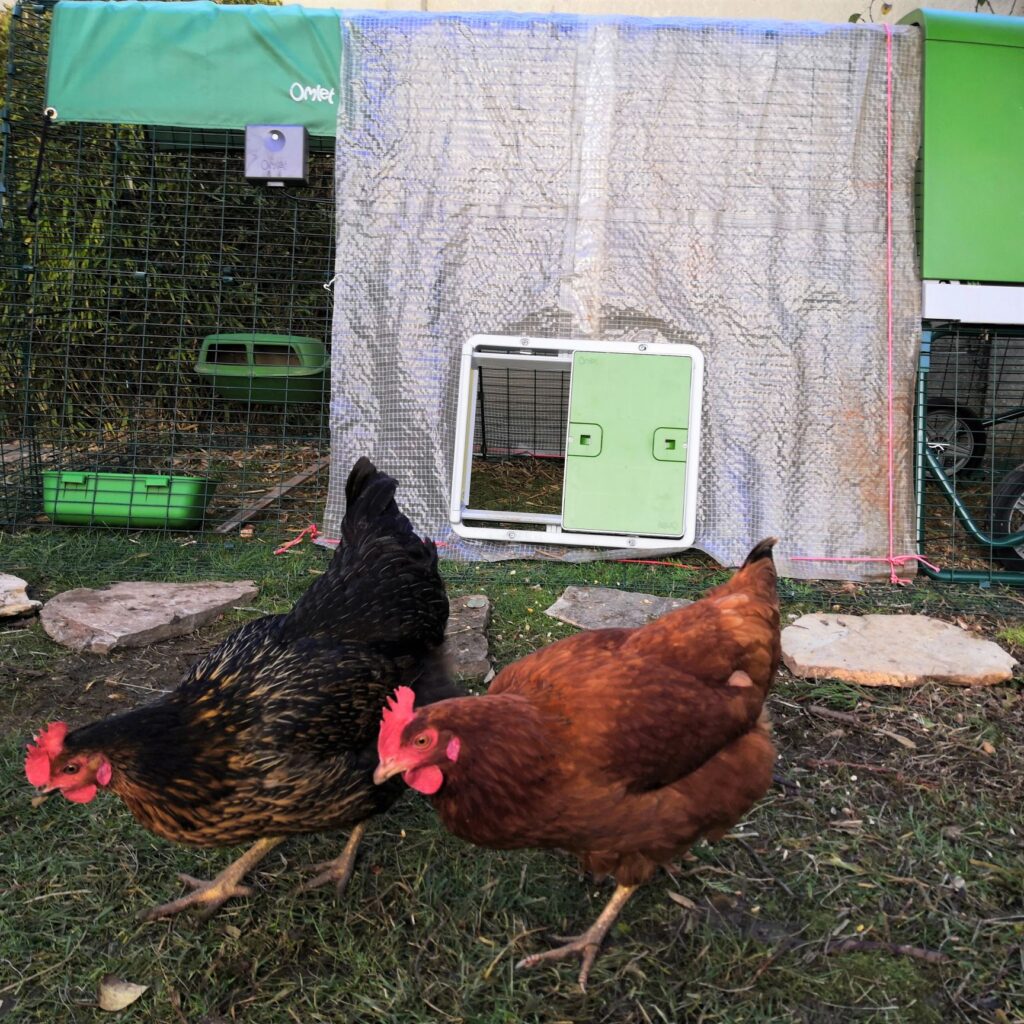
Miny and Résy are very pleased with their brand new Autodoor from the Omlet Grotto. No more waiting to be let out to play!
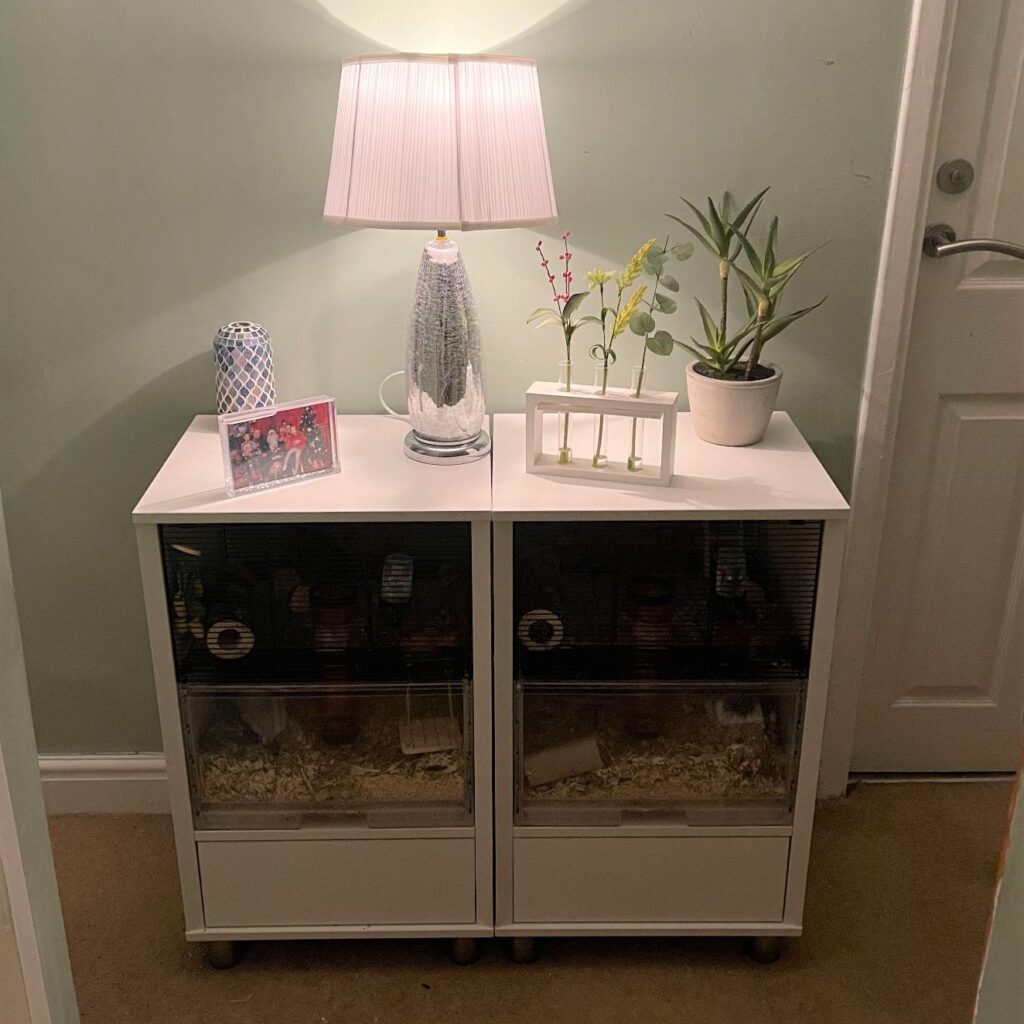
Clare now has a second Qute Gerbil Cage from the Omlet Grotto, so she can expand her clan of gerbils!
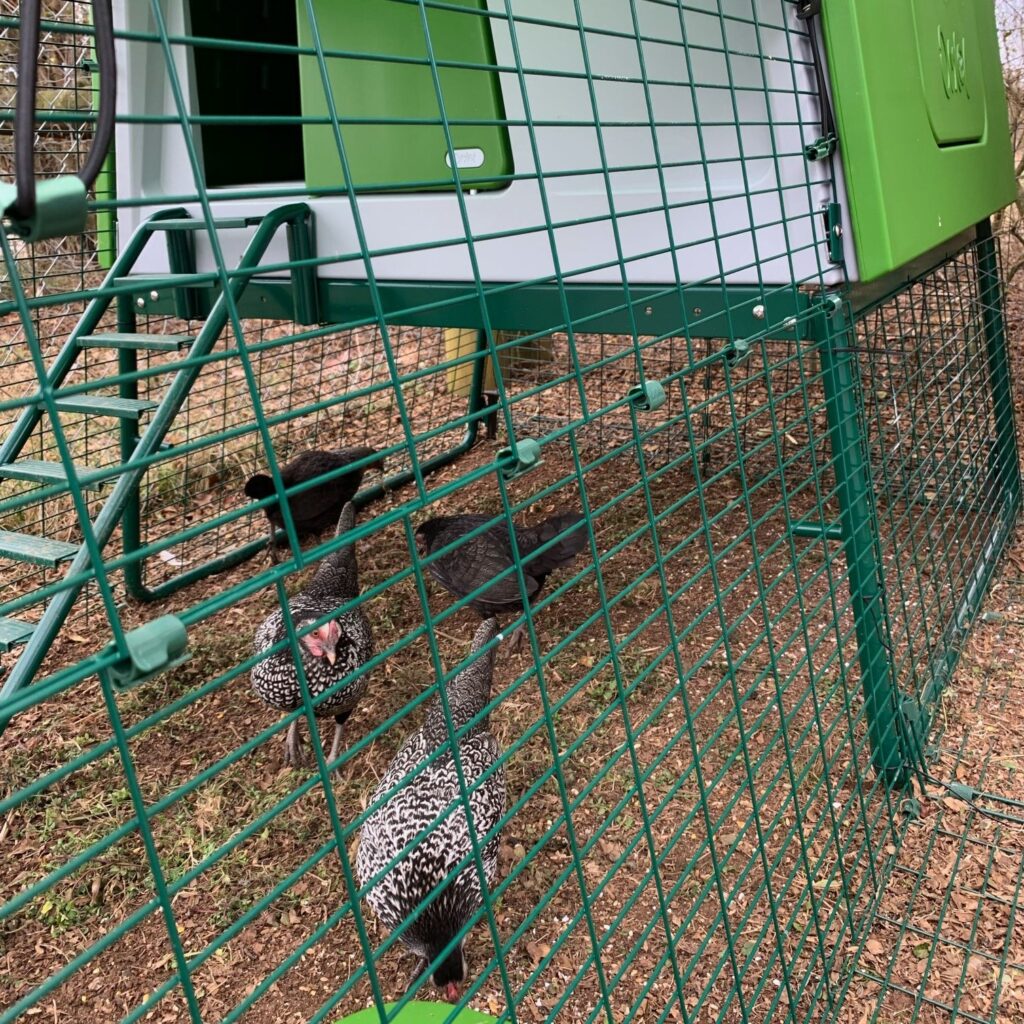
Since receiving the Eglu Cube from Santa, Cinnamon has been gifted three new hen friends to play with!
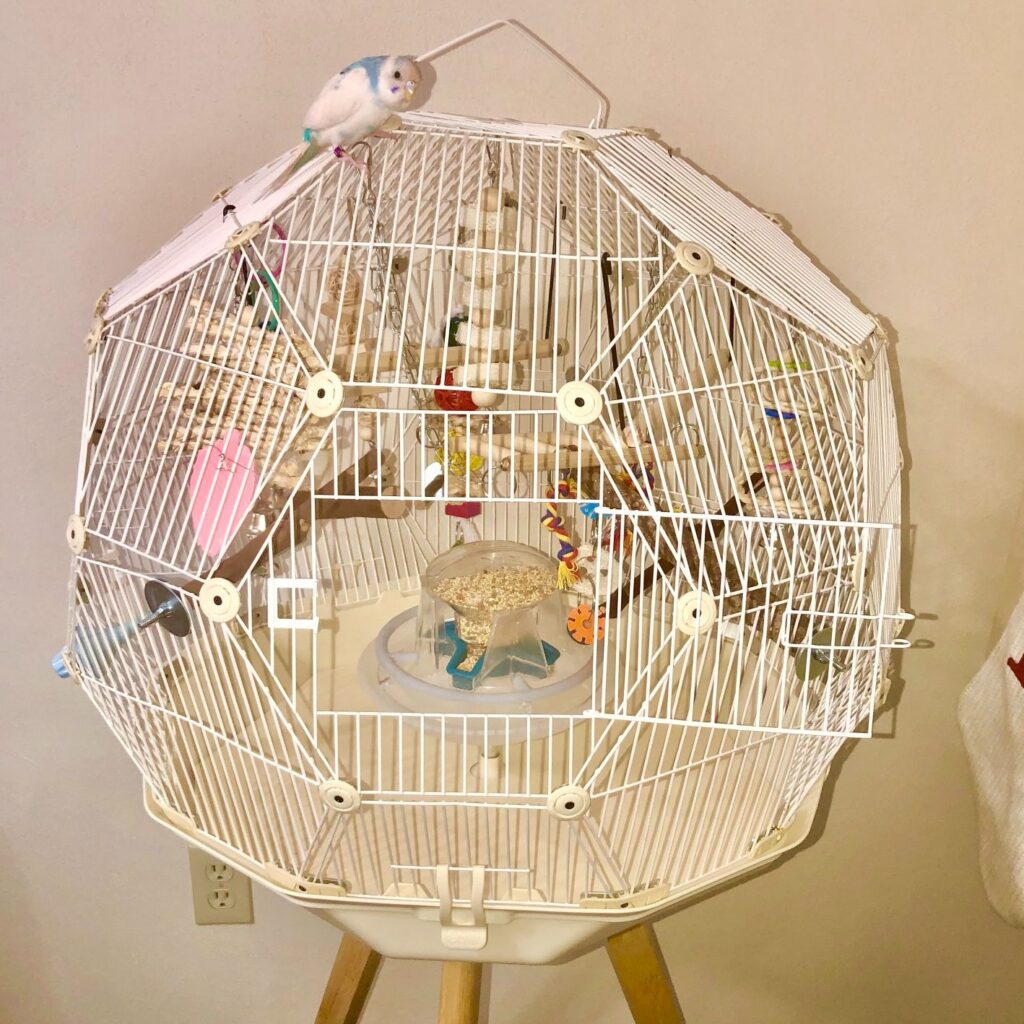
Skye is super happy with her new Geo Bird Cage from the Omlet Grotto and can’t wait to have a new friend in February!
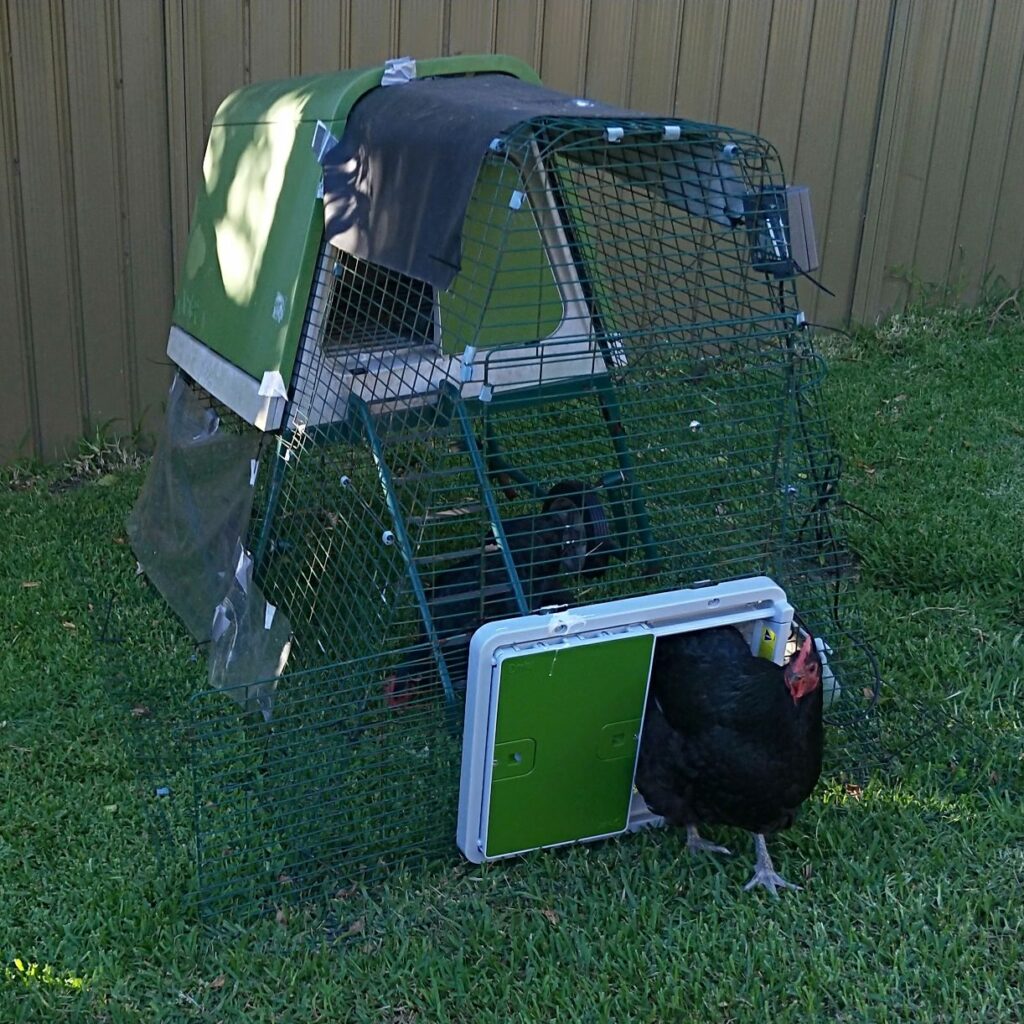
Lady, Stephanie and Freya are loving the new Autodoor for their Eglu Go UP in sunny Sydney!
This entry was posted in Competitions
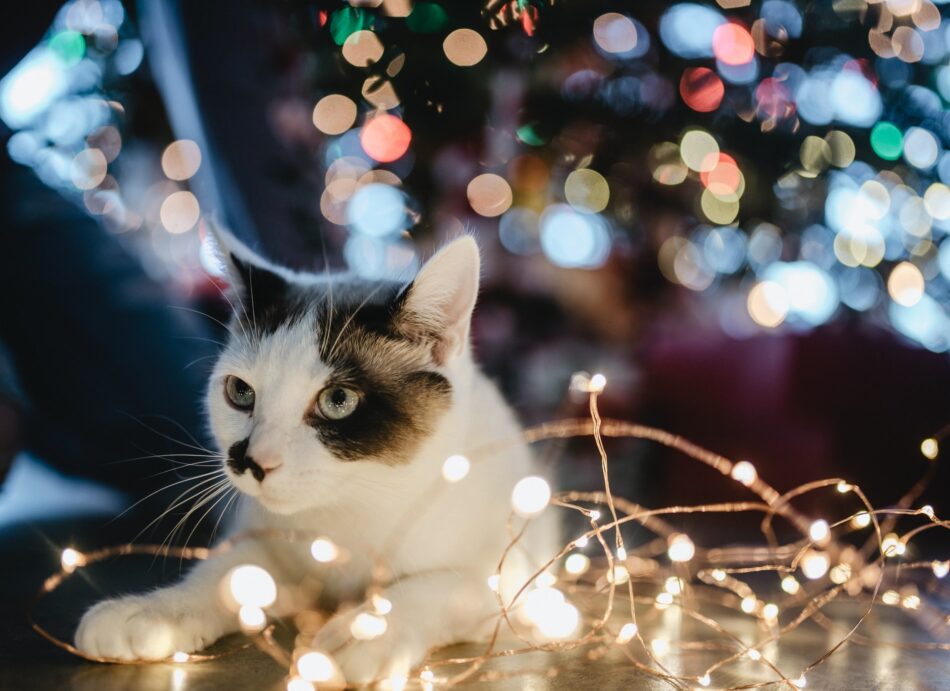 Photo by Jasmin Schuler on Unsplash
Photo by Jasmin Schuler on Unsplash
Holiday Animal Quiz: Can you Identify the roles of these animals in these holiday movie favorites?
1.What does the Grinch tie to Max’s head in the movie?
A. A twig
B. Holly
C. A bell
D. Mistletoe
2.What does the Grinch steal from a mouse when he is stealing from the Who’s in Whoville?
A. A piece of cheese
B. A cookie
C. A candy cane
D. A crumb
3. Who provides the voice of Rebecca the Hen in the 2017 holiday movie “The Star”?
A. Mariah Carey
B. Keegan Michael Key
C. Aidy Bryant
D. Gina Rodriguez
4. In “A Charlie Brown Christmas”, why is Snoopy decorating his dog house?
A. For Charlie Brown
B. For a holiday contest
C. For Santa
D. For Woodstock
5. In the movie “Annie”, what is the name of her beloved Dog?
A. Goldie
B. Molasses
C. Sandy
D. Butterscotch
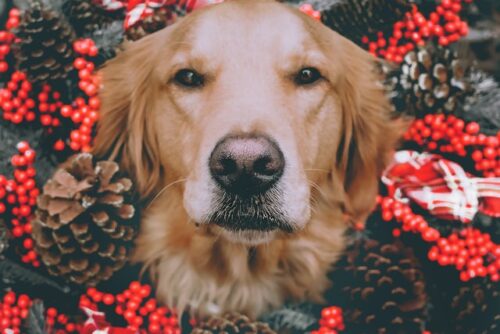
6. In the movie “The Holiday” what is the name of Kate Winslet’s Dog?
A. Charlie
B. Chip
C. Jackson
D. Pip
7. What animal says the line “Bye Buddy, I hope you find your dad!” in the movie “Elf”?
A. A whale
B. A seal
C. A narwhal
D. A polar bear
8. What is the name of Snoopy’s bird sidekick in “A Charlie Brown Christmas?”
A. Tweetie
B. Sunny
C. Pebbles
D. Woodstock
9. What is the name of the famous red-nosed reindeer?
A. Rudolph
B. Prancer
C. Dancer
D. Comet
10. How does Rudolph help Santa on Christmas Eve?
A. His nose helps detect rain or snow
B. His nose detects which houses are on the naughty or nice list
C. He flashes his nose to the airplanes to make way for Santa
D. He guides his sleigh
Answers: 1.A, 2. D, 3. A, 4. B, 5. C, 6. A, 7. C, 8. D, 9. A, 10. D
This entry was posted in Christmas
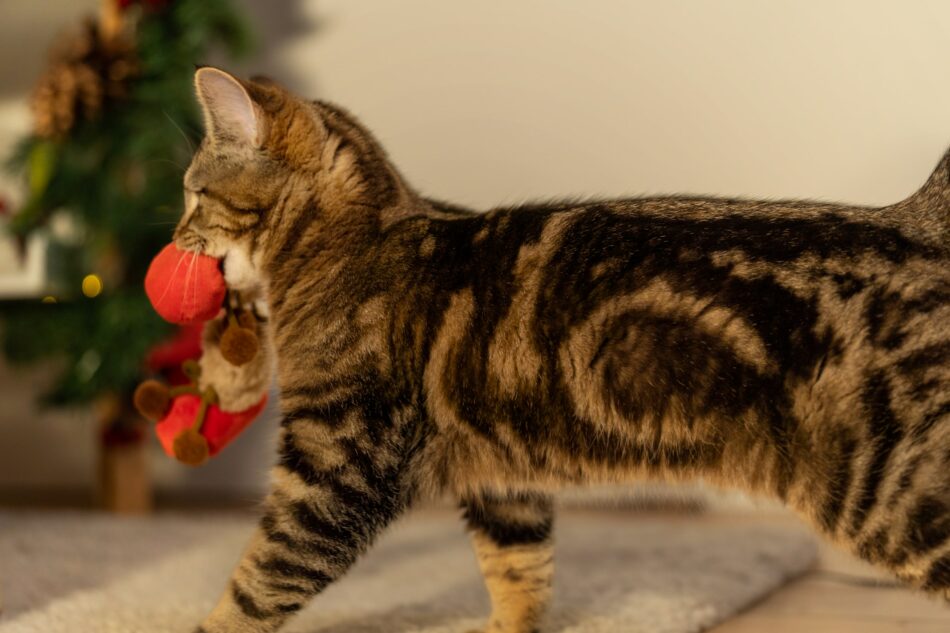
The holidays offer a great opportunity to spend quality time with family and friends – and that includes pets. But, it’s also important to remember that what we enjoy about the festive season isn’t the same for our furry or feathered friends. With a bit of care and consideration, though, you can make sure the holidays are a fun time for your pets too. These ten top tips for helping your pets to have an amazing holiday break will set you on the right track.
1. Turn down the volume
Christmas and New Year are noisy, with people, music and games all adding to the decibels. For cats and dogs, it may simply be a case of looking for a quiet spot, although many dogs will even be perfectly happy at the center of the party. Caged pets such as budgies, finches, parrots and small mammals, though don’t find it so easy to escape the noise.
If possible, cages should be placed in a quieter part of the house if there’s a party taking place in the main room. The Omlet Qute Hamster Cage is the perfect home for one Syrian hamster or two gerbils, with optional wheels to make moving their space from one room to another easy.
2. Forgo the fireworks
The biggest bang comes from fireworks. While some pets will simply head for a safe corner, others are absolutely terrified. If you’re the owner of a nervous pet, speak to your veterinarian as they may be able to prescribe medication to help them relax. For cats and dogs, you can also try pheromone diffusers a few weeks before the fireworks begin. Take a read of our pets’ guide to surviving fireworks blog for more tips on pet safety during this time.
3. Go easy on the treats
There’s lots of food around at Christmas. Your dog will be more than happy to eat leftovers and treats all day, given the chance, but this doesn’t make it a good idea. As far as your dog is concerned, it’s best to treat Christmas and New Year like any other day, perhaps with a simple treat such as a few slices of plain turkey with the evening meal.
The same applies to other pets, and you’ll also need to make sure that everyone knows the rules. A well-meaning guest might try to feed pretzels and salted peanuts to the hamsters and gerbils, or pieces of Christmas cake to the pet birds. These human snacks will bring no benefit to your pet, and some items are even highly toxic. You can find our series of pet-safe festive foods here:
Christmas foods to avoid giving kitty
Christmas treats for rabbits and guinea pigs
Holiday food do’s and don’ts for dogs
4. Hang on to some routine
During the holiday season, it’s easy to lose your routine. You’ll probably be in bed later than usual, enjoying a few too many lie-ins, and preoccupied with children and guests. With everything else going on, there’s a chance that daily tasks such as refilling your pets’ food bowls, closing the hen house door or even skipping the dog walk can fall off the radar.
Most pets will already be thrown by a change of environment from all the Christmas decor, so it’s important to minimize stress as much as possible and keeping their routine as familiar as possible will help.
5. Visitor pep talks
Some dogs love crowds and attention from new people, but even the most sociable of canines need time to chill. Chances are, you’ll have plenty of visitors over the holiday season and some pets won’t appreciate all the extra fuss.
Speak to guests beforehand about your pet’s temperament and what the boundaries are. If there are young visitors, be wary of potential cage-rattling and chasing pets. You also need to remember that birds like to have lights out in the evening, so make sure your late party doesn’t turn into an all-nighter for the budgies, finches and parrots, too. If the room isn’t too noisy, a bird cage cover might suffice; otherwise, relocating the pet cage will be the best option.
6. Keep the pets at home
If you’re traveling away for Christmas, arrange for someone to look after your pets. Consider a cat sitter or chicken sitter if you’re planning on an extended trip away. If this isn’t possible, look into local catteries and kennels.
You can consider taking your dog with you if you’re heading away for the holidays, though. Fortunately, there are many dog-friendly vacation spots available, meaning Fido doesn’t have to miss out on the fun.
7. Winter weather safety
If you’re planning on keeping your pets in another room for the Christmas party, or if they are kept in the backyard all year round, you need to take special measures to ensure they remain warm.
Cats and dogs will benefit from a super cozy pet throw such as the Faux Sheepskin Dog Blanket and Super Soft Cat Blanket from Omlet. Opt to place them on your bed or theirs for optimum comfort and warmth.
For smaller pets kept outside, take a read of our Will my rabbit be okay in winter? guide and our How to prepare guinea pigs for winter blogs. Chickens might be kept outside whatever the season and are hardy pets, but extra precautions should be taken over winter. A well-insulated chicken coop such as the Eglu Cube will go a long way in keeping your flock toasty but they’ll also appreciate an extra layer of protection on their coop from temperature protection jackets.
8. Clean up time
The Christmas season tends to involve lots of pet hazards – wrapping paper, bows, ribbons, tinsel, and bits of plastic to name just a few. To avoid these items ending up in your pet’s mouth or wrapped around their legs, be sure to get everything tidied away once the presents have been opened.
9. Christmas tree watch
A Christmas tree can easily be bashed by wagging dog tails and adventurous cats attempting to climb. For one, it’s a good idea not to have heavy decorations high up on the Christmas tree, as these could easily fall and break, and nothing fragile (or valuable) should be kept within reach of an excited tail.
If your cat’s fascination with the tree doesn’t wane, get them a Christmas tree of their own with the Switch Cat Scratcher. Put simply, it’s the coolest cat scratcher since time began. With the help of tech and tireless testing from our in-house cats, we’ve designed a cat scratching post that your Christmas tree definitely won’t be able to compete with.
With over 1,200 irresistible light modes, the Switch is attractive to our eyes as they are fascinating to feline ones. Plus, with a bamboo base that lasts indefinitely and 100% biodegradable sisal sleeves, your cat’s Christmas wish will be granted all year long.
10. New pet? No worries
You’re probably familiar with the saying that a dog is for life, not just for Christmas, but the same applies to any pet. If you’ve carefully considered that pet ownership is right for you and you have the resources to do so, bringing them in amongst the festive chaos isn’t the best time to put your plan into action But, if you have had a recent animal addition to the family in the past few months, navigating their first Christmas is something you need to account for.
First of all, make sure that new cats and dogs have been introduced to any other pets that could be joining you over the season to avoid potential confrontations. Also, ensure that your home is still pet-proof with any decorations you’ve added to your usual setup. This will likely be their first time experiencing a Christmas and New Year, so pay special attention to how they’re reacting, making sure to remove them from situations that are making them uncomfortable.
Omlet and your pet’s holiday
At Omlet, we know that pet ownership over the holidays isn’t always as glamorous as your festive family portrait might portray. Christmas tree chaos, gatherings and winter weather might be obstacles but with Omlet’s range of innovative pet products such as our Switch Cat Scratcher, easy clean Eglu Cube Chicken Coop and cozy Faux Sheepskin Dog Blankets, we can help make the holidays as smooth sailing as they can be.
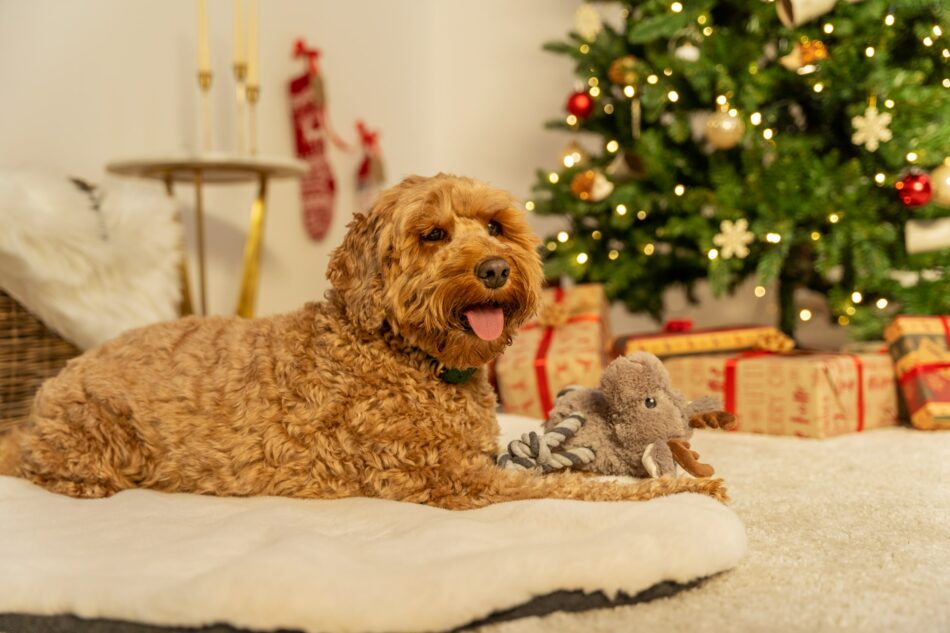
This entry was posted in Christmas
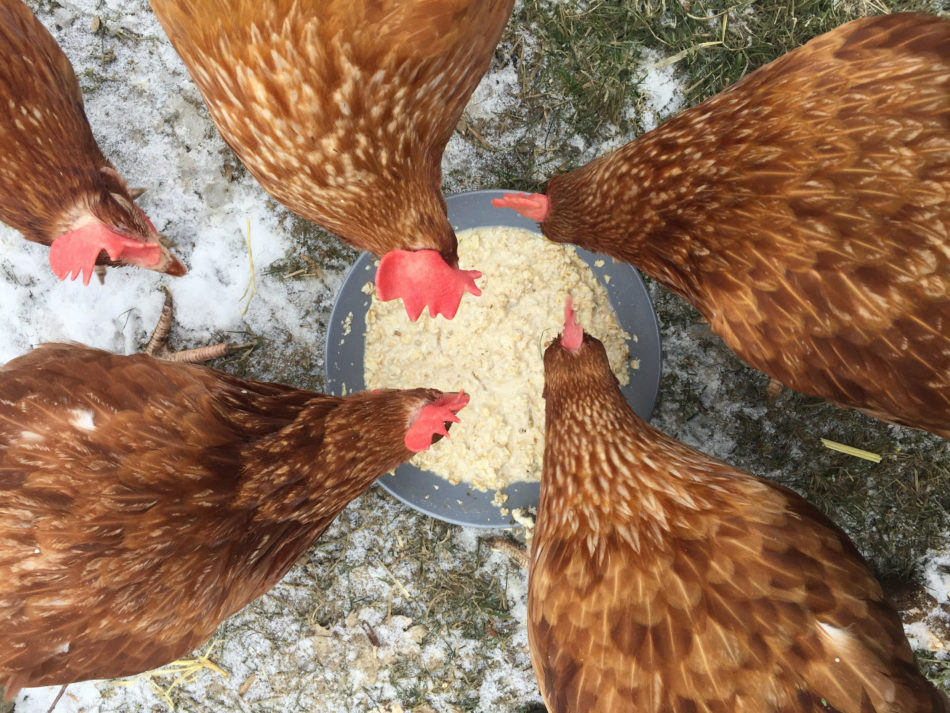
Introduction:
As November and December start to roll in, the cold weather will come with it. You may have already purchased the Omlet Eglu Cube or Go-UP to keep your chickens cozy during these cold nights. However, who said you do not want to spoil your chickens even more over the holiday season?! It is the season of giving after all! Below is some information on feeding your chickens in colder months and some “egg-cellent” treats that you can surprise your hens with on a cold, blustery day that they will absolutely love!
Blog Summary:
- How often should I feed my chickens during Winter?
- What is the most comforting treat?
- What are the easiest treats to prepare?
- What are the most nutritious treats for your flock?
- Conclusions
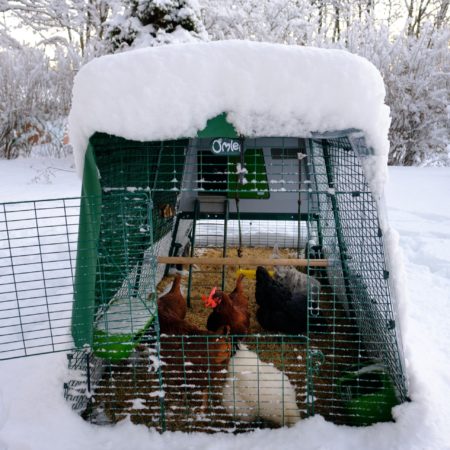
1. How often should I feed my chickens during Winter?
During the colder months it is normal that other animals hibernate and usually stock up on food for the Winter. With your chickens it may be helpful to feed them a little more than their usual ration, especially if you are planning to have your chickens continue to lay eggs throughout the colder season. A good rule of thumb is if you feed them 1 time a day, give them half of an extra ration in the Winter.
2. What is the Most Comforting Treat?
If you have already bought some pumpkins to paint or to decorate your doorstep with in the Fall Season and are wondering what to do with them here is a solution, Pumpkin Puree! This is a great treat for your hens that you can easily whip up in minutes.
All you have to do is scoop out the seeds and cut the pumpkin into small enough pieces that they can be put in a food processor or a blender. Then, just blend it up until it is a nice, smooth consistency for your chickens. After you have pureed the pumpkin, take it straight out to your chickens and add some chicken feed and they will go crazy!
Another option is also to warm up the Pumpkin Puree for a warm treat on a colder day! Make sure that the puree has cooled down to a comfortable temperature before you feed it to your hens.
3. What are the easiest treats to prepare?
Sometimes simpler is better and these treats will definitely keep your hens happy and maybe give you a little laugh in the process.
One easy treat to give your hens is leftover pasta! Who knew that chickens like to load up on carbs in the Winter as well! If you have some leftover spaghetti or penne toss it into the chicken pen and you will get a good laugh watching the chicken have noodles hanging from their beaks.
Another easy treat is warm oatmeal! Just add hot water and stir. You can also add some chicken feed or any nuts and seeds that your chickens prefer. You will be amused watching your chickens try to slurp up the warm oatmeal. Again, make sure the oatmeal is at a comfortable temperature to serve to your hens.
4. What Winter Foods Are Healthy for my Flock?
For those of you that like to keep your flock in tip top shape here are some ideas for healthy treats. One food that helps with egg production and is very nutritious is scrambled eggs! I know it sounds crazy, but it provides your chicken with needed protein and vitamins during the Winter months.
Also, egg shells believe it or not will provide your chickens with extra calcium and nutrients that they will need even more during the colder months. After you have used one of your chicken’s eggs just break up the shells into small pieces and feed it to them. They will love it!
5. Conclusions
All of these recipes can be found from this great website: https://morningchores.com/chicken-treats/. Go check out her page for more ideas on treats for your chickens and help your chickens stay warm and cozy this season!
Psssst… Read More About Fun Pet Tips and Tricks Here: https://blog.omlet.us/
This entry was posted in Chickens
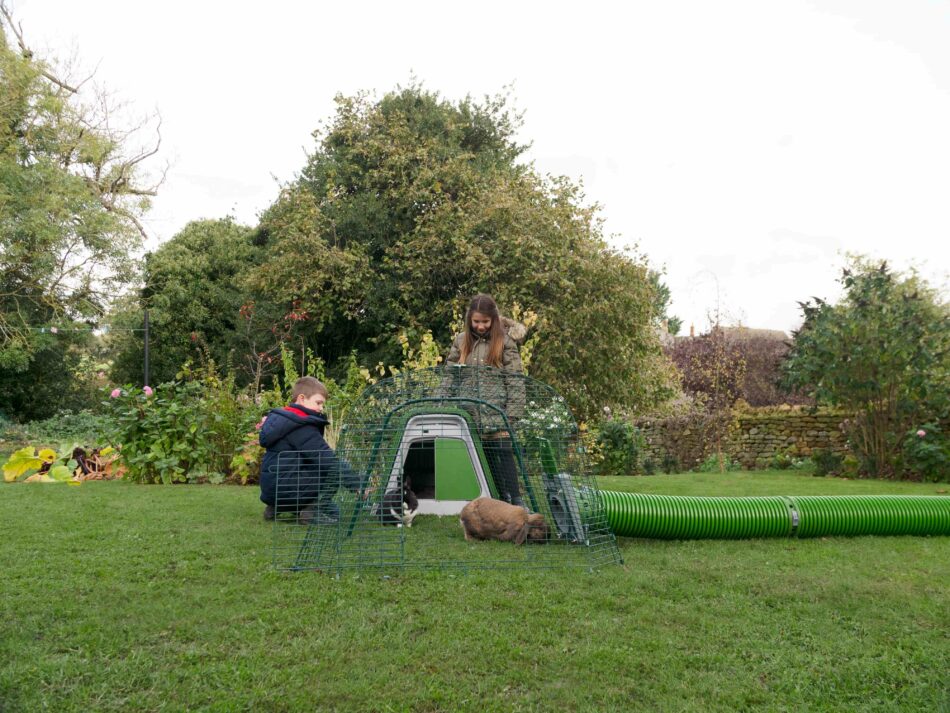 We often get questions about whether rabbits will be okay outside in the winter. The simple answer is: yes. But things get a little more complicated when you consider the specific climate, individual rabbits, and their setups. We’ll share how you can safely keep your outdoor rabbits outside during the winter, and how to determine if and when it’s time to bring them inside.
We often get questions about whether rabbits will be okay outside in the winter. The simple answer is: yes. But things get a little more complicated when you consider the specific climate, individual rabbits, and their setups. We’ll share how you can safely keep your outdoor rabbits outside during the winter, and how to determine if and when it’s time to bring them inside.
Can rabbits live outside during the winter months?
Rabbits that are accustomed to living outdoors are well-equipped to handle the winter months. At this point in the year, you’ve probably noticed your outdoor rabbits’ fur looking mottled due to a process called molting. Molting in rabbits is a natural process that prepares their coats for the winter months ahead, and is triggered by the amount of daylight. So, if your rabbit is outdoors during summer and fall, the dwindling daylight hours signal them to start shedding their thinner summer coat in order to regrow a more dense coat for the winter.
Once they’ve donned their winter coats, your rabbits can withstand the colder outdoor temperatures quite well. In fact, rabbits are much more comfortable in the cold than they are in the heat. But, in order for their natural insulating layers to be effective, bunnies need dry, clean areas to shelter in.
In the wild, rabbits will warm up in underground warrens, or burrows, and huddle together for warmth. Domesticated rabbits need a similar environment – a draft-free, dry hutch to warm up in. The Eglu Go Rabbit Hutch was designed with this in mind. The twin-insulated walls offer protection from drafts while containing the natural body heat of your rabbits within. And, our hutch is designed to provide ample ventilation to prevent moisture buildup, which is especially important during the winter months.
But will they be happier inside?
It may be tempting to bring your outdoor rabbits inside for the winter, but the trouble with this is threefold:
- Bringing your bunnies inside for more than brief visits acclimates them to your home’s interior temperature. This makes it more difficult to move them back outside without shocking their system.
- The artificial lighting in your home will disrupt their biological clock, which may cause them to shed their winter coat too early.
- They will need indoor accommodations away from the hustle and bustle of your home activities. Rabbits may become stressed by stimuli such as televisions, radios, children playing, or other loud noises – especially around the holidays.
Rabbits that are well adjusted to their conditions and schedules outside will thrive much better staying in their home all year round – including during the winter. If your rabbits have lived outside for the rest of the year, save for a couple of caveats.
How cold is too cold for rabbits?
Rabbits don’t adhere to a particular rule when it comes to temperatures. What is true for most bunnies might not apply to others. Observe your bunnies as well as the weather in order to gauge how cold is too cold for your rabbits. If temperatures have been gradually declining over several weeks, your rabbits’ coats should be sufficient to keep them warm enough in even sub-zero temperatures. But, here is where the first caveat of bringing your bunnies inside comes in:
- If the temperatures have been mild for weeks, and your area experiences a sudden and brief cold snap, you may want to consider bringing your rabbit indoors.
This is because a rapid and temporary drop in temperature can be too much for a rabbit that hasn’t finished growing its winter coat. However, the addition of extreme temperature protection on your rabbits’ hutch is enough to bolster your bunnies through a quick cold spell. You can also move your rabbits to a sunnier area of your yard, or under the shelter of a garage or shed in the event of freezing precipitation.
The other caveat to leaving your bunnies outdoors is their health:
- Older rabbits, or those with health conditions that may affect their coats or metabolisms should spend seasons with extreme temperatures indoors.
They don’t have to miss out on all the fun though. Rabbit runs and playpens can be utilized both indoors and outdoors to create safe spaces. On mild winter days, your rabbits will appreciate a romp outside in the sunshine.
What can I do to help my rabbits in winter?
This advice applies if you keep rabbits in an outdoor rabbit hutch and run. If you’re moving your pets inside you won’t have to worry too much about protecting them from bad weather.
Regularly checking in on your rabbits is one of the best ways to ensure they’re in good health, and give you an idea of how well they’re handling the weather. But, there are some other ways you can help your rabbits through the winter.
Exercise
Exercise helps ramp up your rabbits’ metabolisms to help keep them warm during the winter. Make sure they have plenty of space and opportunity to stretch their legs and generate heat. Connecting their hutch to a Zippi Rabbit Playpen via our Zippi Rabbit Tunnel System gives them plenty of room to burrow, explore, and play.
Location
Keep your rabbits’ hutch in a place that receives as much sun during the day. Use clear rabbit run covers during the winter months to allow warming rays of sunshine in for your rabbits to stretch out. If your area receives a lot of snowfall, the addition of wheels and handles to your rabbit hutch allows for quick and easy movement to shelter or shoveled areas.
Bedding
You’ll find your rabbits spending more time in their hutch during the winter due to both decreased daylight hours and temperatures. Make sure to change their bedding frequently to keep them clean and dry. Choose a thick bedding like straw and provide a thick layer for your bunnies to burrow into.
Diet
Your rabbits should have unlimited access to timothy hay all year round, as well as a serving of quality pellets daily. To stoke their metabolisms during the winter, gradually add in alfalfa hay or pellets into their diet to provide extra energy. Other treats like leafy greens can be served in a Caddi Rabbit Treat Holder to keep it up off of the frozen ground.
You’ll also want to switch to a crock or bowl for their water during the winter months to prevent bottles from breaking in freezing temperatures. A bird bath heater or plug-in heated pet water bowl can be used to keep their water thawed – just be sure that the cords are not within your rabbits’ nibbling range.
Your outdoor rabbits with Omlet
Don’t stress over your rabbits during the colder weather. With our Eglu Go Rabbit Hutch, Zippi Rabbit Runs and Playpens, and Zippi Tunnel System, you can create a winter wonderland that both you and your rabbits can enjoy. With dry, insulated dwellings, your bunnies will boldly take on the chilly temperatures – and you will rest assured knowing they’re comfortable and happy not just during this season, but all year round.
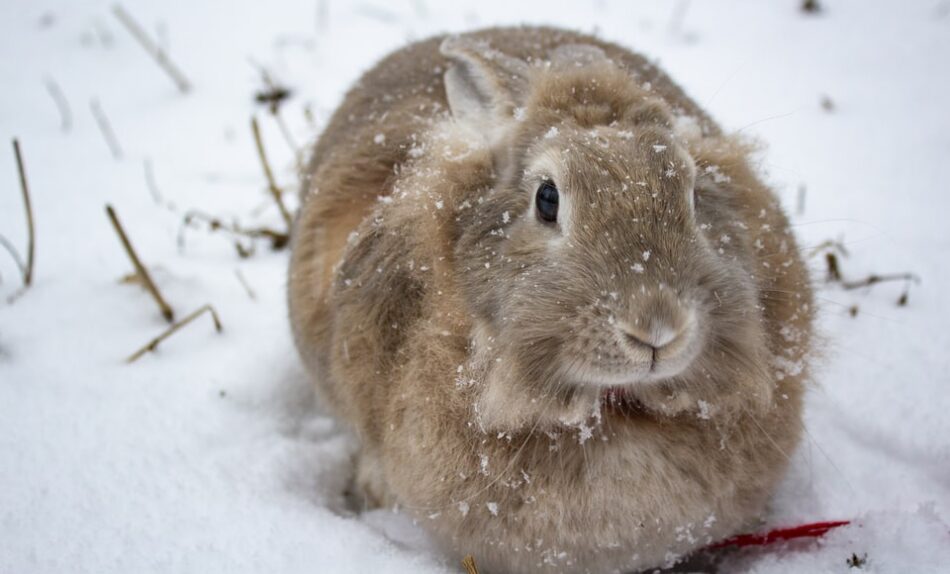
This entry was posted in Rabbits
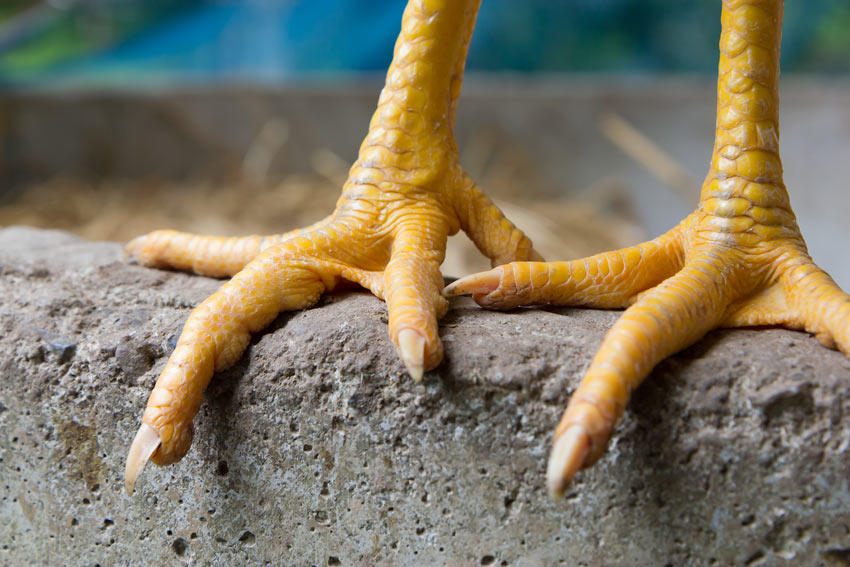 Watching chickens scratch at the frozen ground or strut through the snow, you might wonder how they manage to keep their feet and legs warm. After all, this is one part of their body with no feathers to keep it cozy (unless you happen to have a feathery-legged breed such as the Cochin, Brahma or Silkie).
Watching chickens scratch at the frozen ground or strut through the snow, you might wonder how they manage to keep their feet and legs warm. After all, this is one part of their body with no feathers to keep it cozy (unless you happen to have a feathery-legged breed such as the Cochin, Brahma or Silkie).
Surprisingly, the simple answer to ‘How do they keep their leg warm?’ is ‘They don’t!’ Those skinny, bare legs have scales, which retain heat to a certain extent, but they will still get very cold if the bird stands still for too long.
And that’s the important detail. A chicken keeps its legs warm by moving, and by not keeping all its toes on the ground for too long. These parts of their body lose heat rapidly; but the solution is quite simple.
Perching is the most effective way of retaining heat. A hen hunkers down when roosting, and her legs are tucked into her warm body. If space allows, install a flat perch too. A piece of wood with a 10 cm width will enable the hens to roost without having to grip the perch, which in really cold weather will prevent their toes freezing. (The lucky ones will simply snuggle down in a nesting box, which is the chicken equivalent of a thick quilt!)
But of course, a hungry hen doesn’t want to waste the whole day perching, so even in the coldest spells she will make a lot of contact with the ground.
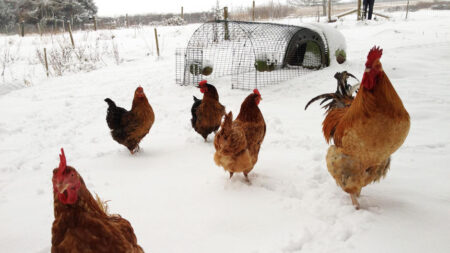
One-Legged Hens
Like many other birds, chickens often adopt the ‘one leg’ look, tucking one of their limbs up into the warmth of their bellies. This reduces overall heat loss and stops feet and toes from freezing on the icy ground.
An upturned pot, a log, pallet or other slightly elevated space – cleared of snow or ice – will help the hens get the circulation going again, without having to catch their breath on the frozen ground. Like all birds, chickens are warm-blooded, just like us, and their own body heat soon works its magic. Indeed, with an average body temperature of around 41°C, chickens can remain active in the coldest weather.
The leg-warming process is helped by other tricks, too. Fluffing up the feathers retains body heat, by trapping small pockets of air which are then heated up by the bird’s warm body.
Some owners give their hens a supper of corn and grains, which take longer to digest than a standard pellet or other chicken food. Part of the digestion process involves producing heat – a kind of internal hot water bottle!
In general, hens will eat more food in the cold months, as more of their energy is spent keeping warm. Some owners like to supplement the birds’ diets with extra protein or a little suet, to increase their fat levels for the winter. Fat retains heat, and the whole bird benefits – not just the legs (which will remain as thin as ever!)
Help With the Heating
You can help your hens keep their toes cosy by making sure the coop is clean and dry. Clear out any snow dragged in on the birds’ feet and keep an insulating layer of straw on the floor. You can give the birds extra protection by insulating the coop – although there should still be some ventilation, to allow the gases released from the birds’ droppings to escape.
You can install an automatic door to help keep the living quarters snug. Heaters are also available – but never use anything other than a heater designed specifically for hen houses. It’s also best to use these only if the temperature gets below 40°F, otherwise hens may get used to being cosy all the time, and that could be disastrous if the heater fails, and the birds are suddenly exposed. Heat-pampered poultry can die of cold shock.
A chicken coop should be draft-free, but not completely sealed, as ventilation is important for healthy hens. During the day, a sheltered spot in the run or garden will help them take a breather and warm those long-suffering legs.
Chickens are amazingly hardy, and although not exactly warm, their legs will be able to cope with anything the average winter throws at them. As long as they can toast their toes on a nice perch every now and then…
This entry was posted in Chickens
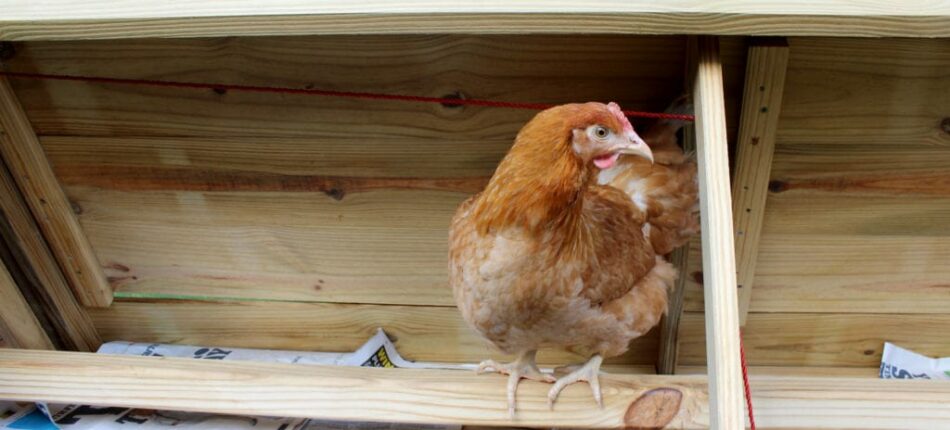
Are your chickens happy in their wooden coop? Is your chickens’ coop strong enough to make it through another winter? Is it time you upgraded your wooden coop? These are all questions many chicken keepers ask themselves when facing the reality that their wooden coop may not do its job, especially for another cold season. Take this short quiz to see whether your wooden coop is ready for this round of wintery weather.
Wood absorbs water – does your coop seem heavier?
A = Yes – either I’m getting weaker, or my coop has gotten heavier.
B = Yes, but I solved it by getting someone else to move the coop for me.
C = I’ve given up trying to move it.
D = Nope, I spent the summer sanding and sealing my chicken coop with a varnish, so now it’s more water-resistant.
Have you had to pour boiling water onto locks to get them to open?
A = Yes, I have to keep a coop de-icing kit.
B = Boiling water sounds easier than smashing the bolt with a rock or brick to get the coop unlatched during a freeze.
C = I religiously grease all hinges and bolts every few weeks to keep things moving.
D = I have very carefully aligned my coop to the morning sun so that the bolts and hinges have defrosted by the time I get out. On cloudy days I resort to hot water.
Has your wooden coop shifted or expanded since last winter?
A = Yes – the doors all seem too big for the frames, and nothing opens or shuts properly anymore.
B = Yes – the panels have swollen, and now I’m concerned for when they shrink again because I added extra chickens to fill the void.
C = For the most part it appears fine, but some sections don’t align the way they used to.
D = No – the staining and sealing seems to be keeping the coop intact.
Is the roof leaking?
A = Yes – I’ve already fixed the roof a few times this year, and now it’s already leaking again.
B = Yes, but this is the first time and I’m confident that I can fix it myself.
C = No – there aren’t any obvious leaks.
D = My wooden coop is brand new, so I don’t expect to have any problems this winter.
Is it cold and damp inside?
A = Yes – it feels cold inside, and the bedding gets damp quickly.
B = It’s a little chilly, but my hens huddle together to keep warm.
C = I haven’t noticed any dampness, and my hens act alright.
D = The coop keeps warm overnight once I have shut the door, and my chickens are outside during the day.
Did you have difficulties with red mites in summer?
A = Yes – I’ve had to prevent and treat red mites in my coop and chickens regularly, and I’m already dreading the next resurgence.
B = No more than usual – it’s just part of chicken keeping, and I’m used to dealing with them.
C = I had mild issues with red mites, but they weren’t out of control.
D = The red mites didn’t cause a problem in my coop this year.
How long does it take to clean your coop?
A = It’s an all-day task that I dread, so it doesn’t get cleaned regularly in winter.
B = It takes a while, especially in the winter, but I know my hens appreciate it.
C = It takes a few hours, but the whole family helps.
D = It doesn’t take me long at all – I have a good system in place.
The results…
Mostly As = If you experience repeated and frequent issues with your wooden chicken coop like red mites, a leaking roof, or poor ventilation, it’s definitely time to upgrade to a plastic chicken coop. Keeping chickens in the winter doesn’t have to be a dreaded or labor-intensive experience. Plastic chicken coops keep your chickens comfortable, dry, and mite-free all year round.
Mostly Bs = You’ve valiantly kept your wooden chicken coop going this long, and are determined to keep persevering through wooden chicken coop repairs. But the question remains: are your chickens happy in their wooden coop? Keep a watchful eye out for dampness and drafts inside of the coop, as these are extremely dangerous for hens – especially the older members of your flock.
Mostly Cs = You’re no stranger to wooden chicken coops and the potential problems and maintenance they present. But, there are plenty of reasons to avoid wooden chicken coops and to make the switch from wooden to plastic hen houses. Cleaning, comfort, and your overall workload will decrease substantially when you update your coop to plastic.
Mostly Ds = Your wooden chicken coop is in its early days, or you’ve spent countless hours preparing and preserving its integrity. Keep in mind however that all wooden chicken coops rot eventually, and all preservation methods are just that – a temporary improvement until the elements leave their mark on your wooden coop once more. If you’ve just invested in a wooden chicken coop and aren’t ready to make the switch to plastic, consider making some weather-resistant upgrades like an Automatic Chicken Coop Door to keep your hens more comfortable in the cold.
Upgrade with Omlet
Don’t just survive the winter weather – thrive in the cold. With our line of plastic chicken coops, your hens will be warm, dry, and comfortable whatever the weather. The Eglu Cube Chicken Coop is designed for larger flocks to find shelter in the bitter cold. And, with accessories like the Autodoor, you can schedule your flock’s outings to take place during the warmest part of the day, while keeping them tucked in a well-ventilated, draft-free coop at night. See how keeping chickens in the winter doesn’t have to be a chore, just another season to love your flock.
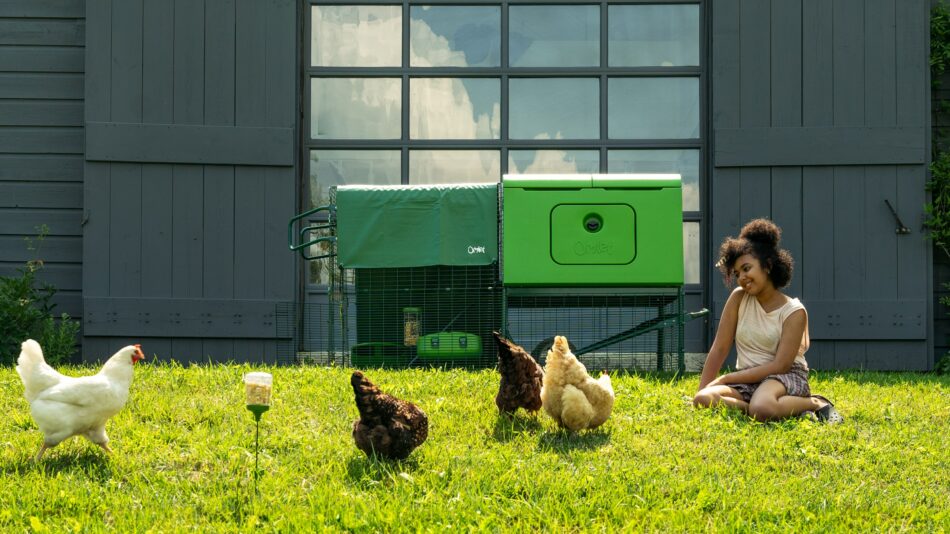
This entry was posted in Chickens
While most people check the weather forecast to help them plan their week activities or outfits, chicken keepers can also be using it to predict what accessories their coop needs to ensure their girls are as comfortable as possible.
From sun to snow, wind to wet, the breakfast time weather reports and the handy app on your phone are all giving you helpful hints that you might be ignoring.
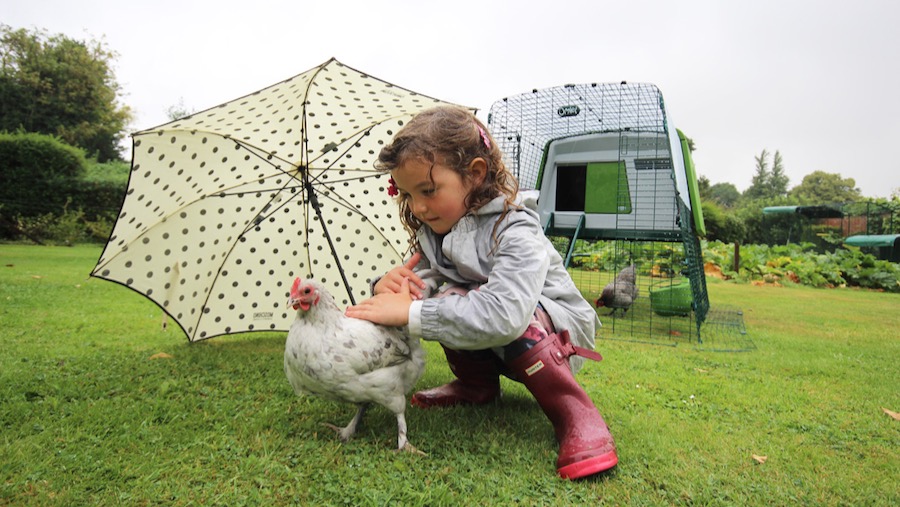
? TEMPERATURE ?
Firstly, the most obvious indicator: the predicted temperature for the coming 10 days. Depending on what time of year we are in, this can be super helpful or utterly confusing if it is varying drastically. But let’s think about what we can act upon.
In winter, if the predicted temperature is at below 32 degrees Fahrenheit for more than 5 days in a row or the temperature is near freezing and you have very few chickens in your coop, you may want to consider attaching the Extreme Temperature Blanket to your Eglu to give your chickens some extra help with keeping warm, without limiting the coop ventilation.
During hot summer months, when temperatures can be above and beyond 85 degrees Fahrenheit daily in some countries, it is wise to move your chicken coop into an area that is in the shade for as much of the day as possible. For your chickens, daily health checks are essential to ensure they are not suffering with the high temperatures. If your coop is attached to or inside a secure run, you can leave your coop door open to increase airflow at nighttime without your girls being exposed to predators.
☀️ SUN ☀️
When the sun is shining, it is tempting to cover your chickens’ run with shades so that it is completely protected from the sun inside. However, this can have the opposite effect on what you intended. Instead of shading and cooling the area, lots of shades create a tunnel which traps the heat, like a greenhouse.
It is best to keep them in a shaded area, and protect one side of the run from the sun. If your chickens are out free ranging most of the day, make sure that they have access to shady patches in the garden, and that their food and water is also in shade.
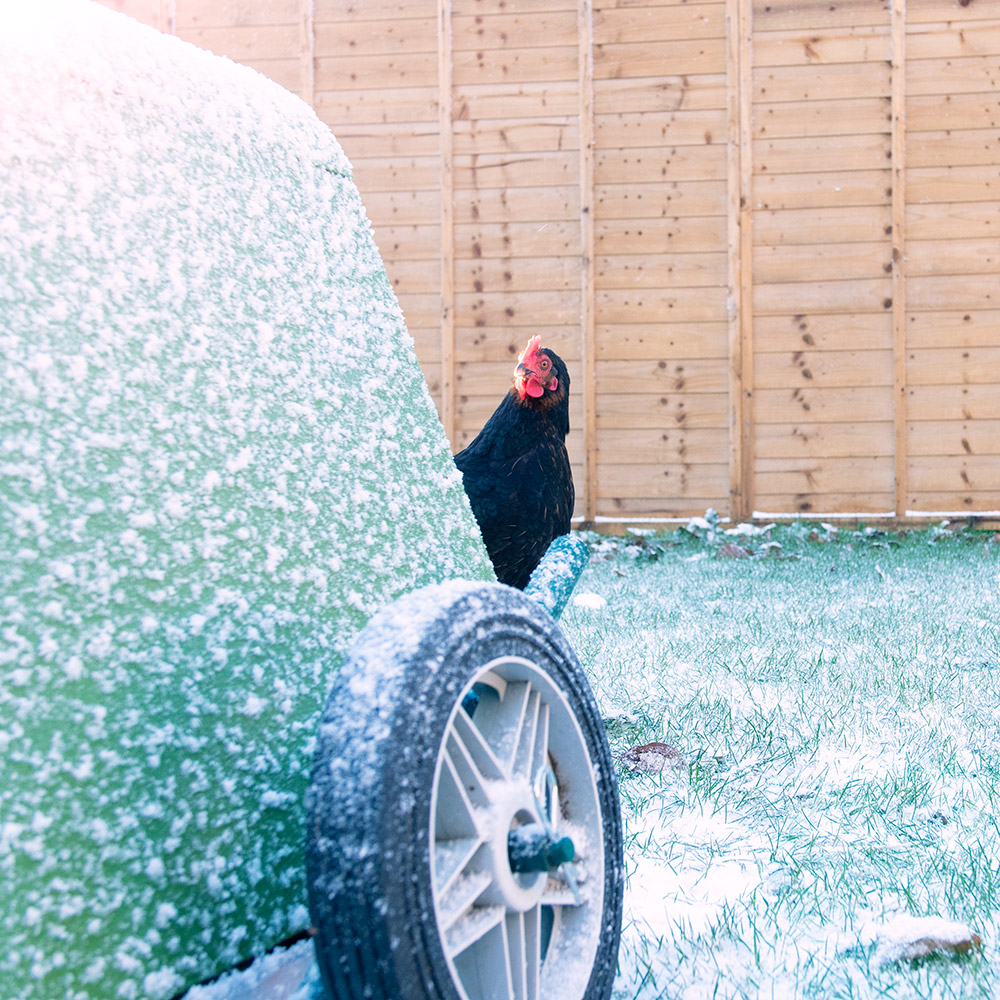
❄️ SNOW ❄️
Exciting for some, but for others a weather warning for snow can be very disappointing. You may want to consider sheltering your coop’s run with clear covers to prevent as much snow getting on the ground inside the run as possible. If snow is predicted for the foreseeable future, you may want to prepare for long term icy conditions and bring your coop closer to the house so it is easier to check on your chickens, and they can benefit from some of the shelter your house might provide. During the snow, be sure to dry off damp feathers and remove any chunks of ice from claws. Increase the amount of bedding and food you are giving your chickens too as this will help them stay warm.
If you have time, it might be wise to consider how effective your chicken coop will be against the bitter cold. If you have a wooden coop, check if it is water-tight and well insulated. If you are not confident in your wooden coop, consider upgrading to a sturdy plastic alternative, like the Eglu Cube. It’s twin-wall insulation works in the same way as double glazing to keep the cold out of the coop, and the heat in during winter. The plastic material is waterproof and super easy to clean out quickly (especially important on chilly winter days).
☁️ CLOUD ☁️
The most boring of all weather forecasts, but often a rest bite from other more extreme conditions. During winter, a few cloudy days should raise the temperature slightly and give you a good opportunity to clean out your coop and thoroughly check on your chickens and make any changes needed for whatever the forecast predicts for the coming days.
? RAIN ?
Some weather reports are more helpful than others when it comes to the exact timing and chance of there being rain. But if you’re looking at days of 90% chance of heavy showers, it would be wise to act fast and get some protective clear covers over the run. If the ground under your chickens’ coop and run is already extremely muddy and wet, you might want to consider moving them to a new patch of grass, and maybe even laying down a base material, like wood shavings, to prevent it developing into a swamp!
? WIND ?
How you react to a windy forecast completely depends on the wind speeds predicted. Light winds, less than 25 mph, shouldn’t cause much of a problem. You might want to add some windbreaks around the base of your Eglu and a large clear cover down the most exposed side. However, in extreme high winds, the worst thing you can do is completely conceal your run, particularly a larger Walk in Run, with covers from top to bottom. In a large run, the mesh holes allow the wind to flow through without causing any issues to the structure, and a clear cover round one bottom corner of the run will provide chickens enough shelter. If you cover the run completely, the wind will be hammering against it and is more likely to cause the structure to lift or move.
If your chickens are in a smaller run attached to their coop, we recommend moving it to a position where it will be most protected from the wind and any falling debris, for example, against a sturdy building wall. The Eglu’s wheels allow you to easily move the coops around your garden to suit the conditions. If you are keeping your chickens in their Eglu coop and run, and not free ranging during dangerous weather conditions, consider adding some entertaining toys and treat dispenser for them to prevent boredom, such as the Peck Toy or Perch.

This entry was posted in Chickens






















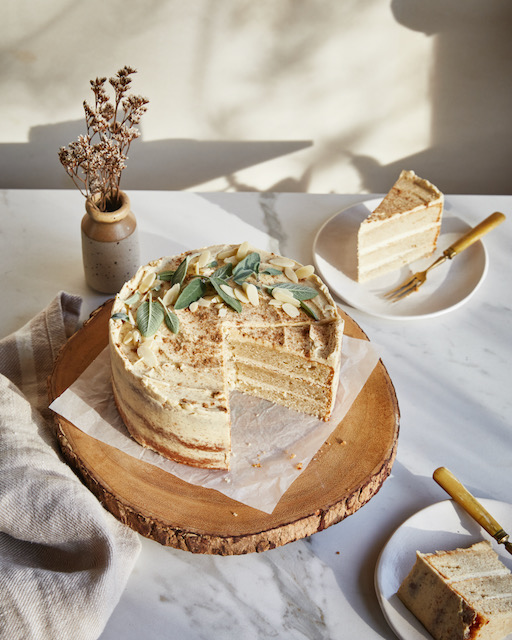
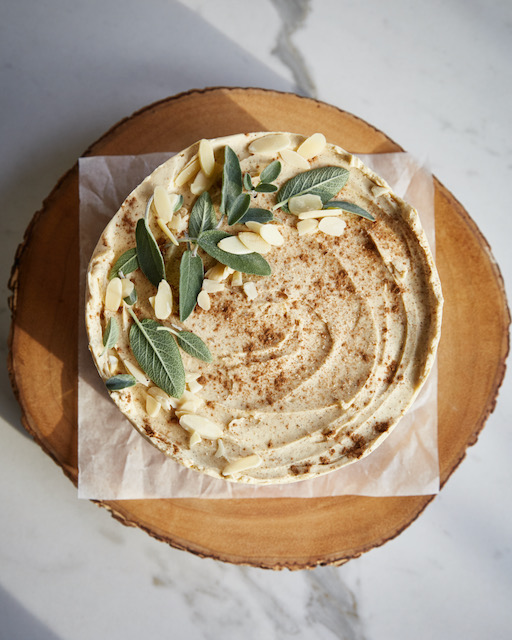
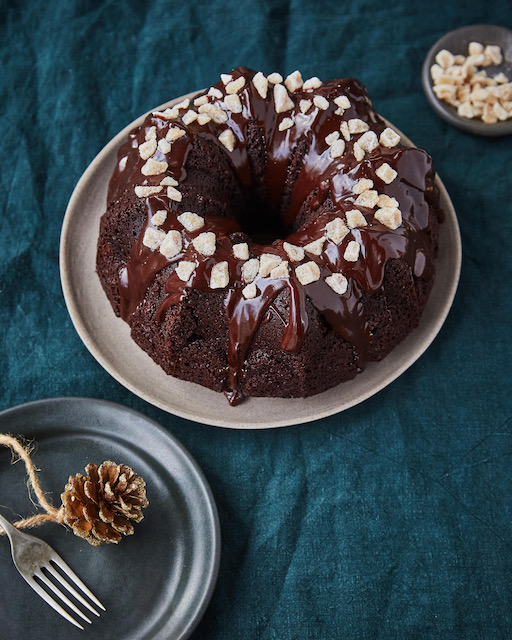
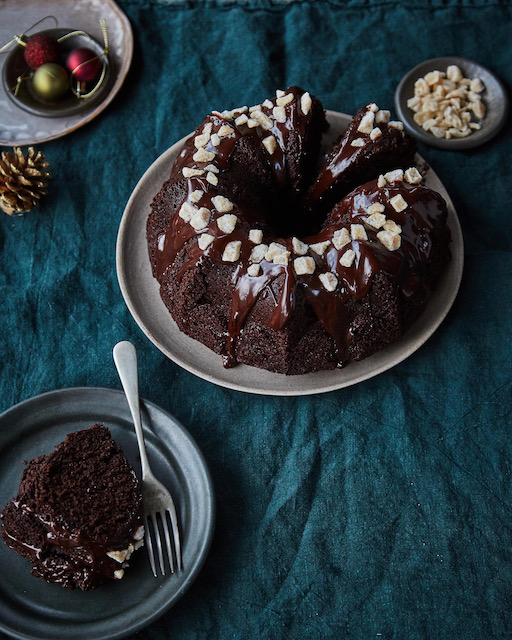


 .
.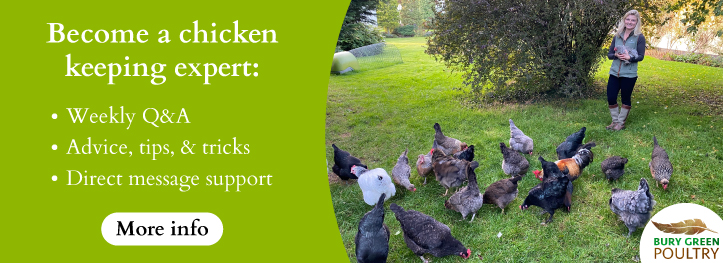






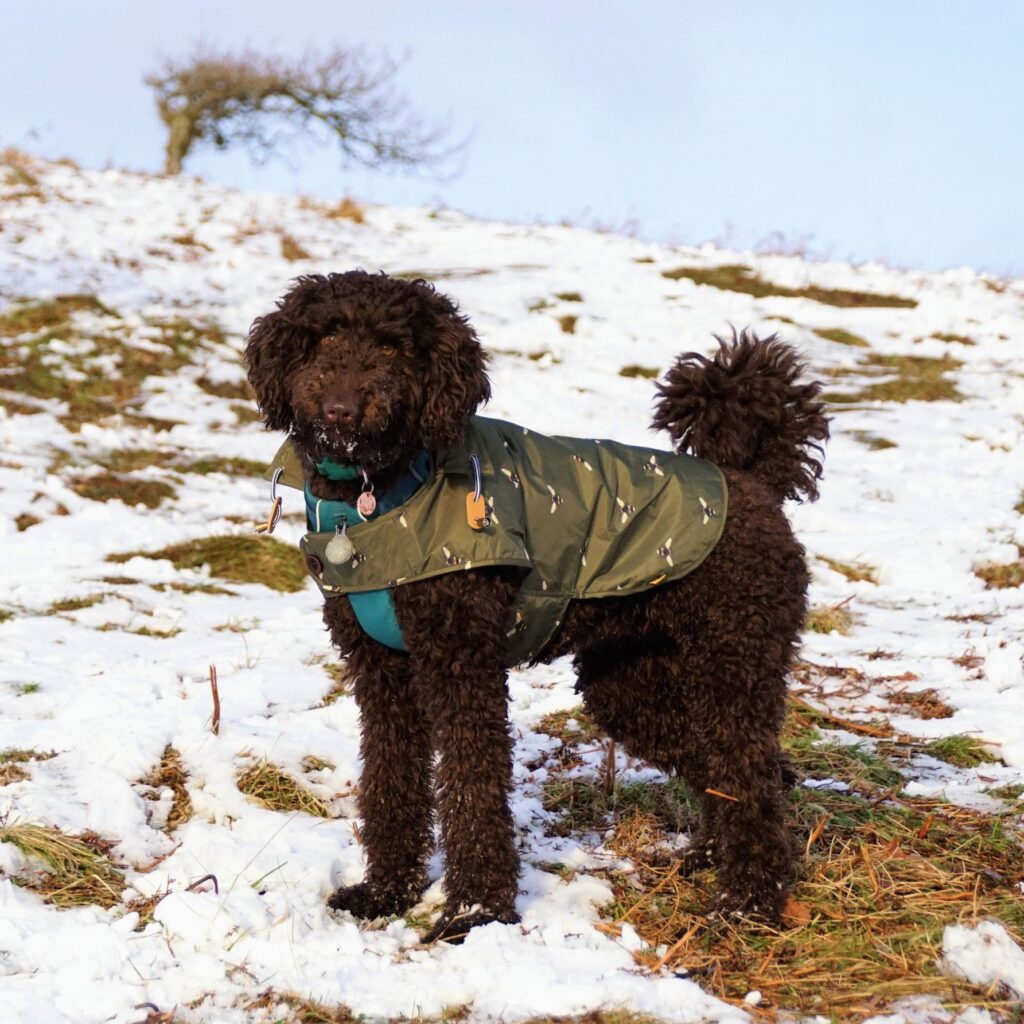
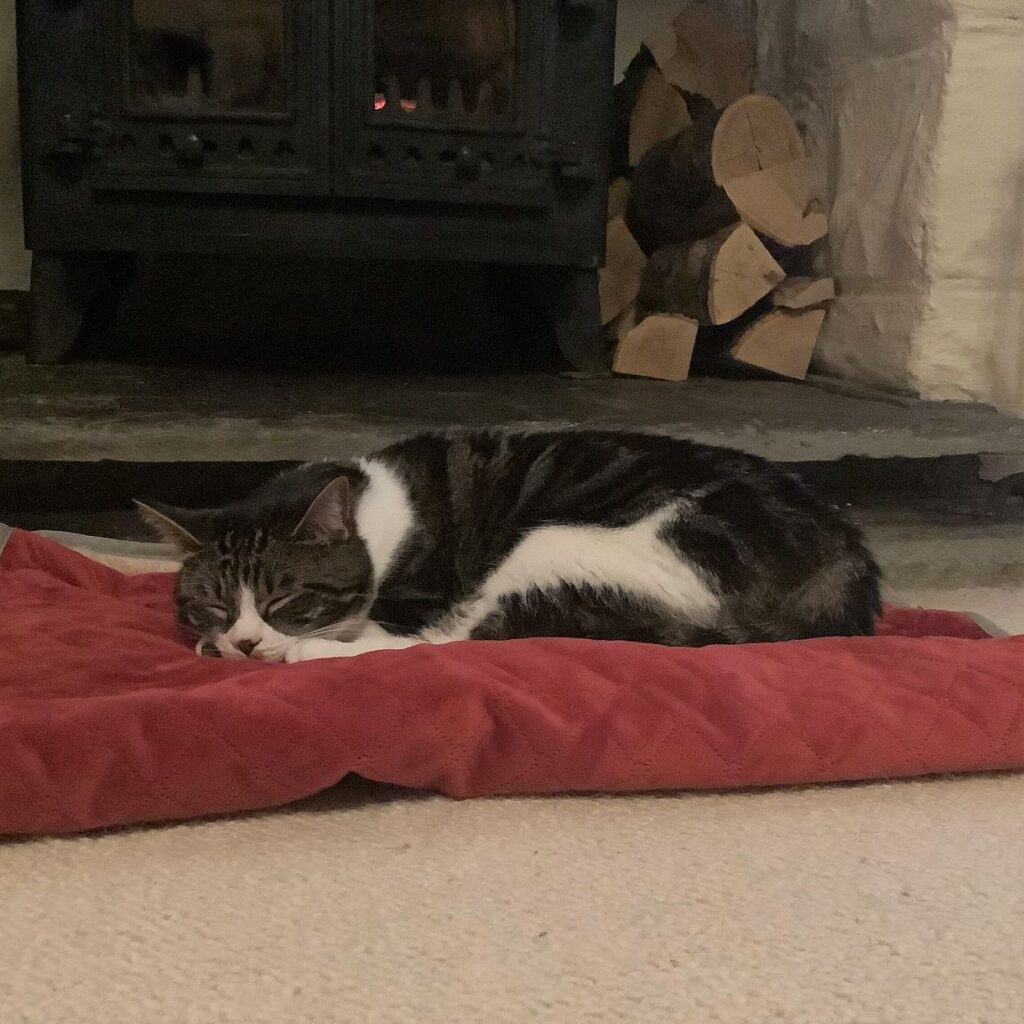

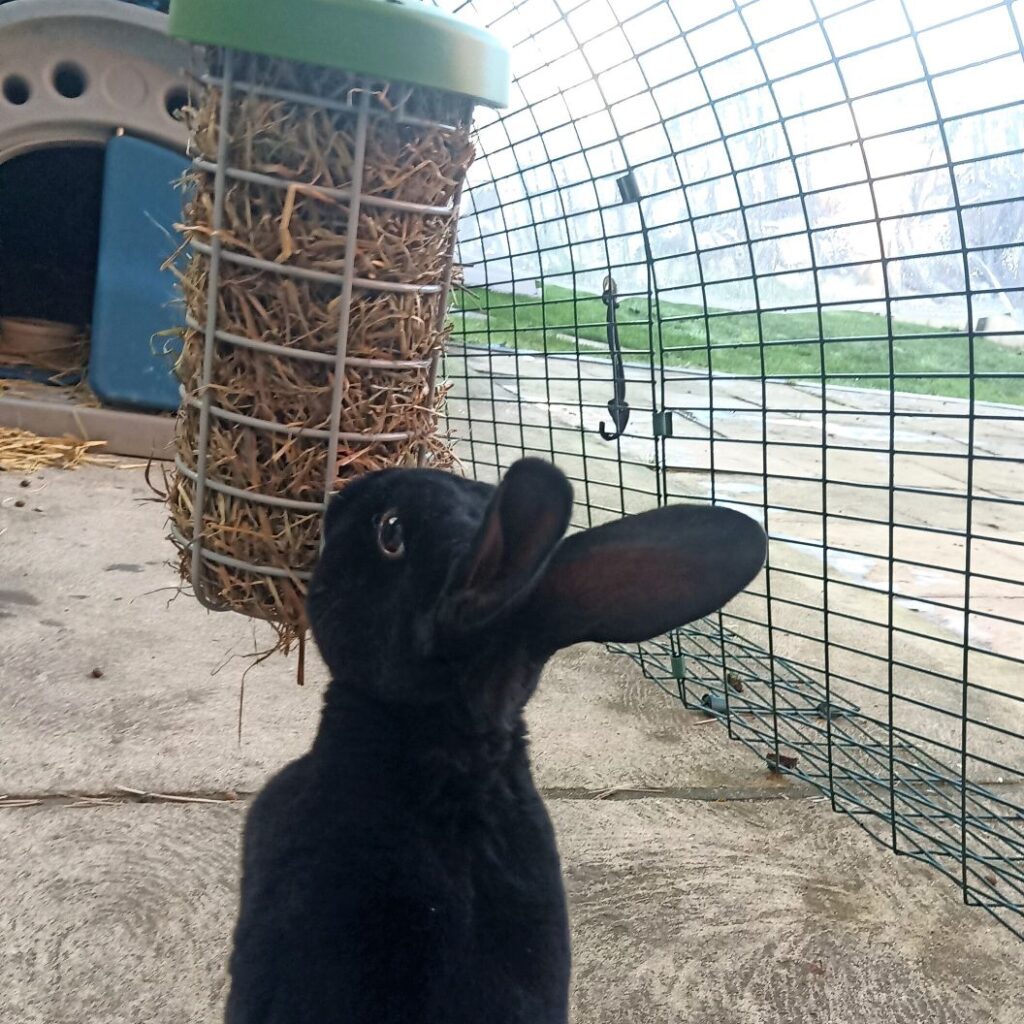


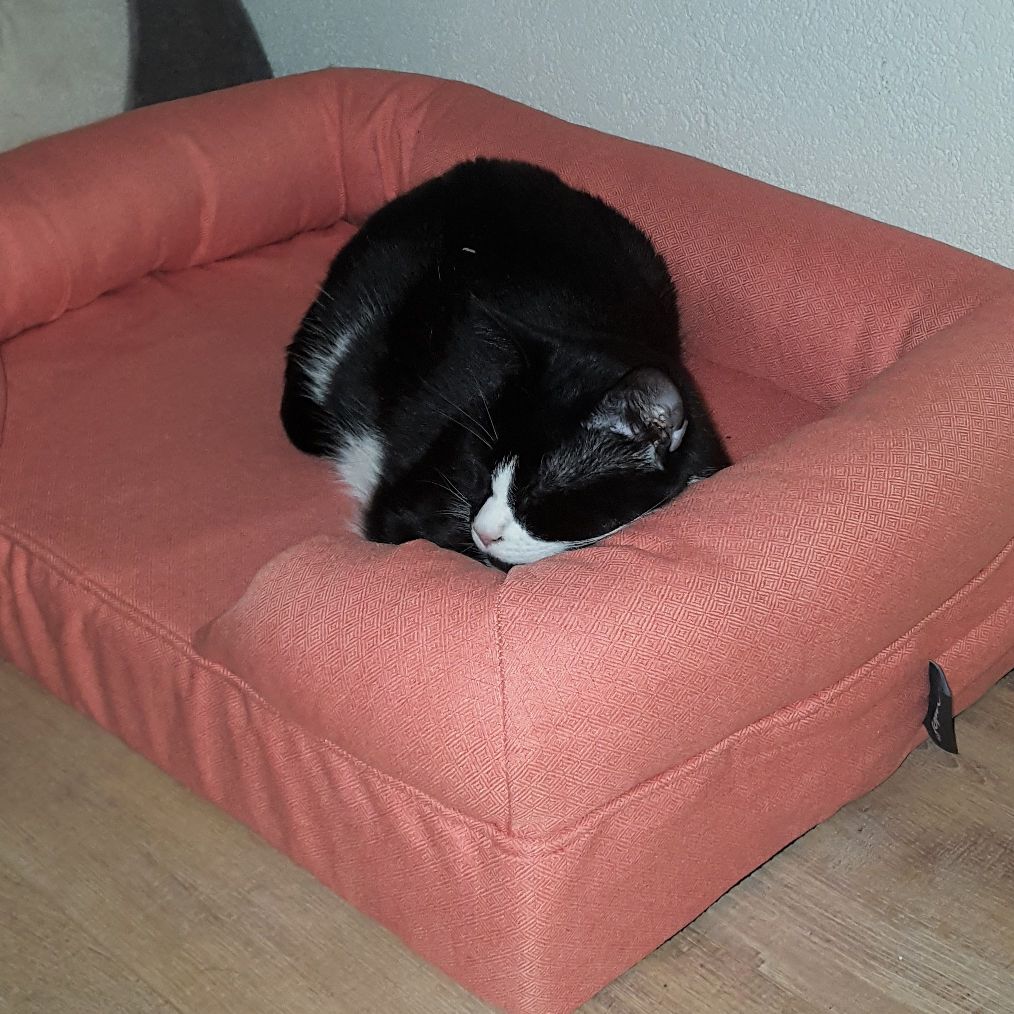





 Photo by
Photo by 






 Watching chickens scratch at the frozen ground or strut through the snow, you might wonder how they manage to keep their feet and legs warm. After all, this is one part of their body with no feathers to keep it cozy (unless you happen to have a feathery-legged breed such as the Cochin, Brahma or Silkie).
Watching chickens scratch at the frozen ground or strut through the snow, you might wonder how they manage to keep their feet and legs warm. After all, this is one part of their body with no feathers to keep it cozy (unless you happen to have a feathery-legged breed such as the Cochin, Brahma or Silkie).




